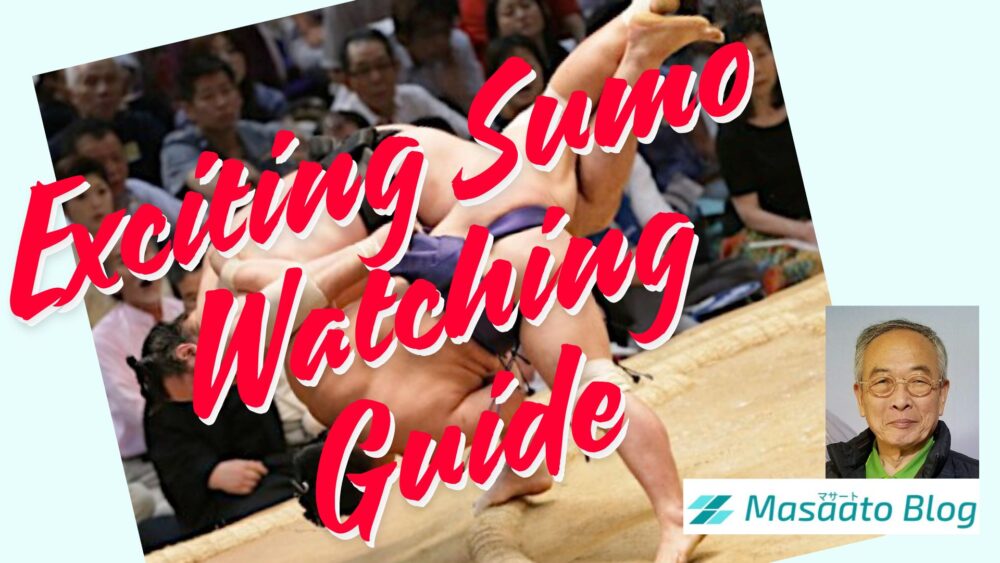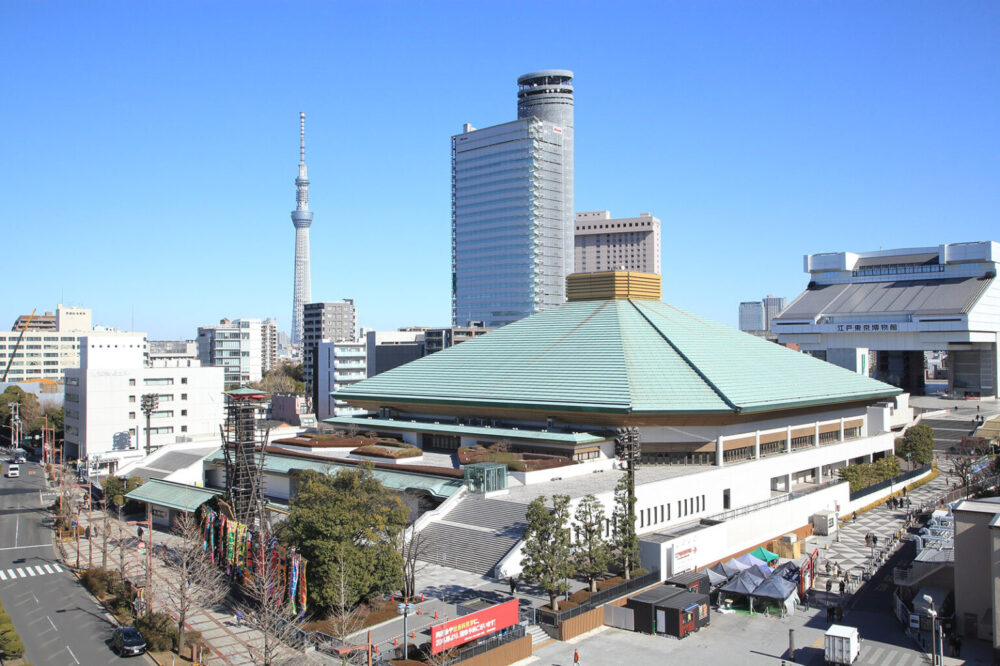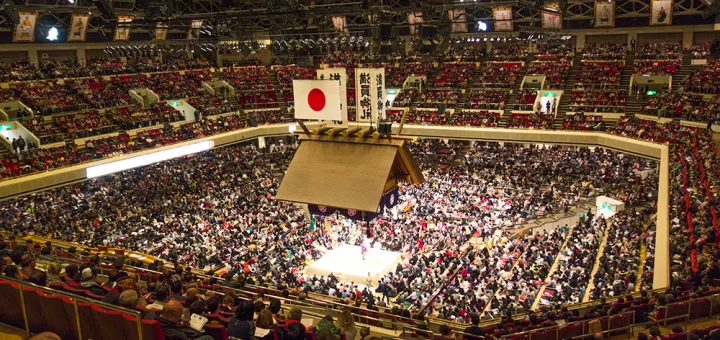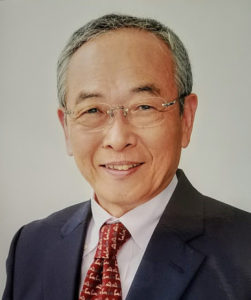Sumo is a very popular sport among both Japanese and foreigners. What makes Sumo different from other sports is that it was originally practiced to pray for good harvest and peace in the Shinto religion.
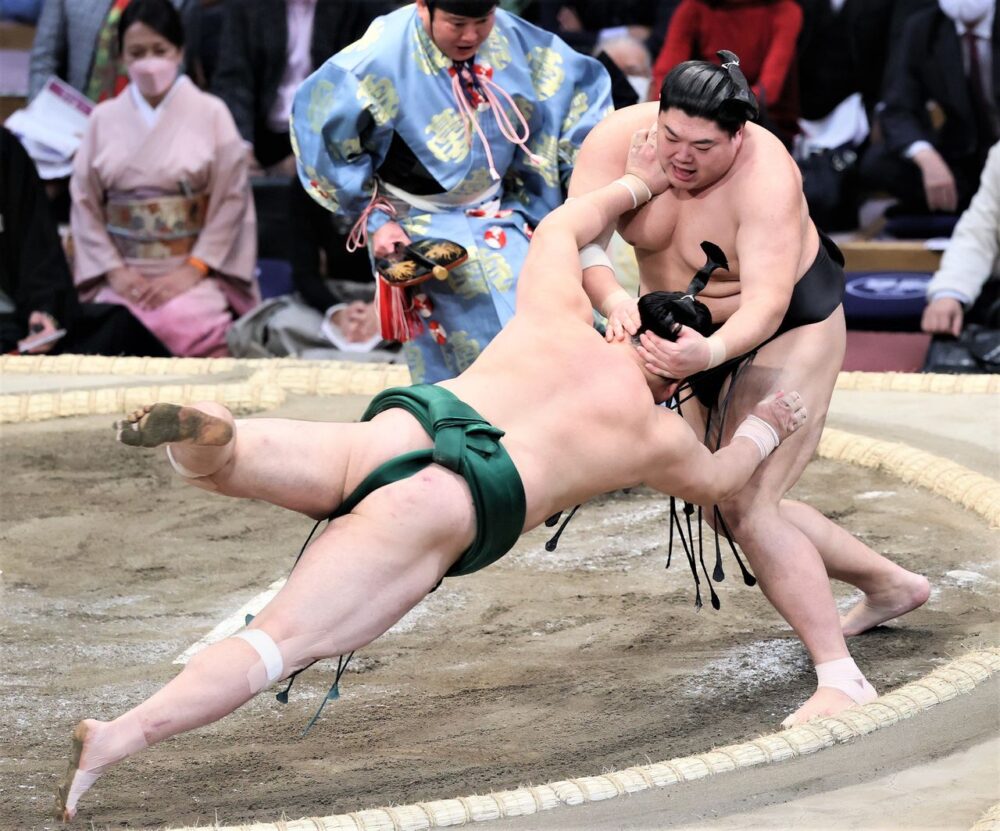
To fight fairly without weapons, the sumo wrestlers wear only Mawashi(sumo loincloth) and no shoes, gloves, or costumes.
Whether they win or lose, they bow politely to their opponents.
Here I have described the charm of such exciting sumo.
The contents of this article are also available in a Kindle edition.
【contents】
- 1. Watching sumo.
- 2. Dohyo-iri (ring ceremony)
- 3. Tenran-zumo (Sumo performed in imperial presence)
- 4. Rikishi (Sumo wrestler)
- 4-1. Banzuke (ranking list)
- 4-2. Six divisions of ranking
- 4-3. Special Awards
- 4-4. Kadoban
- 4-5. Number of the Rikishis
- 4-6. Origin of Makuuchi
- 4-7. Origin of Juryo
- 4-8. Smallest Sumo Wrestler
- 4-9. Average weight and Tall
- 4-10. Heaviest Sumo Wrestler
- 4-11. Treatment
- 4-12. Annual Pay
- 4-13. Eligibility for Rikishi
- 4-14. Physique requirements
- 5. Mawashi (Sumo loincloth)
- 6. Calendar
- 7. Basic training
- 8. Chanko nabe (sumo hot pot)
- 9. Mage (sumo topknot)
- 10. Kokugi (national sport) and Shinji(Shinto ritual)
- 11. Tickets / Arena seats
1. Watching sumo.
1-1. Fair spirit and Courtesy.
Sumo is more than a sport; it is an art of manners and etiquette. It has been deeply involved in Shinto rituals since ancient times.
It is said to be the national sport of Japan. In the sense that one does not carry a weapon and does not do anything improper, the costume is only a loincloth, and barefoot, without shoes.
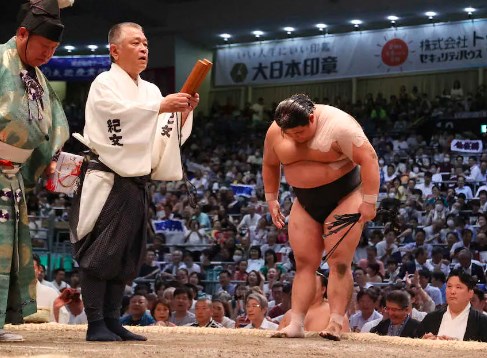
Japanese people love this kind of graceful sport.
Some elementary schools, junior high schools, high schools, and universities have sumo clubs. There are also private sumo schools in the city.
In addition to these amateur sumo activities, there is just one professional sumo organization (Japan Sumo Association=Nihon Sumo Kyokai in Japanese), which holds six sumo tournaments a year.
This is called o-zumo to distinguish it from amateur sumo, where o means big. Japanese people love o-zumo. Zumo is said when the word sumo is joined with the word before it.
O-zumo is also televised overseas and is very popular among people living overseas.
Inspired by the TV broadcasts, some of them came to Japan and became professional rikishi, s sumo wrestler, and some of them became yokozuna (ground champions).
1-2. What is sumo?
Sumo wrestling is a traditional Japanese sport that dates back over a thousand years and is deeply intertwined with Japanese culture and religion.
It is a form of wrestling where two rikishis (wrestlers) face off in a circular ring called a dohyō. The primary objective is to force the opponent out of the ring or to make any part of their body other than the soles of their feet touch the ground.
Sumo is more than just a sport; it is a living tradition that reflects Japan’s cultural heritage, combining physical prowess with ritualistic elements that have been passed down through generations.
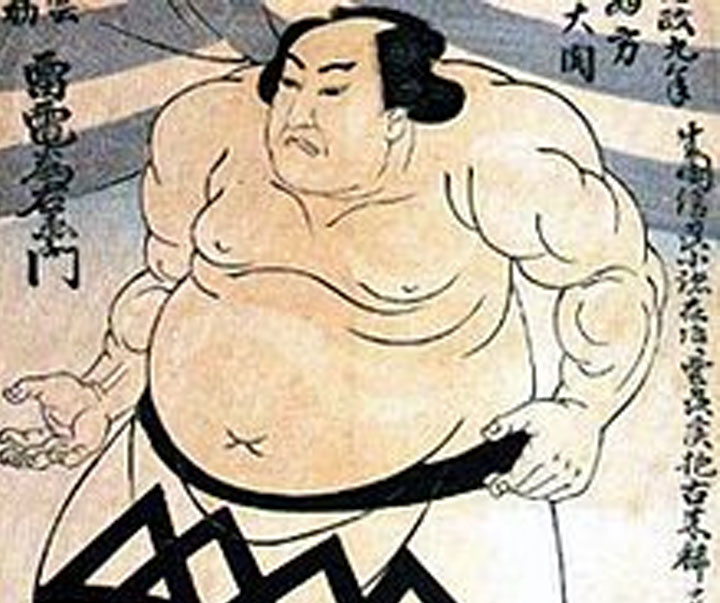
1-3. Rules.
The Ring: We call the ring dohyō. The size of the ring is a square with 6.7 meters on each side, filled with earth and clay, and a circle with a diameter of 4.55 meters is built in the center of the square. The height is 66 cm.
Victory: A wrestler wins a match by either pushing his opponent out of the ring or forcing him to touch the ground with any part of his body other than the soles of his feet.
Slapping is acceptable, but punching is not.
It’s a foul and loss if a wrestler pulls the opponent’s topknot.
Techniques: There are various techniques, or kimarite, that wrestlers use to achieve victory, including pushing, throwing, and tripping.Described later.
No weight division:
There are no weight divisions for rikishis(wrestlers) in sumo; a rikishi weighing less than 100 kg may fight a rikishi weighing 150 kg or more(see the picture).
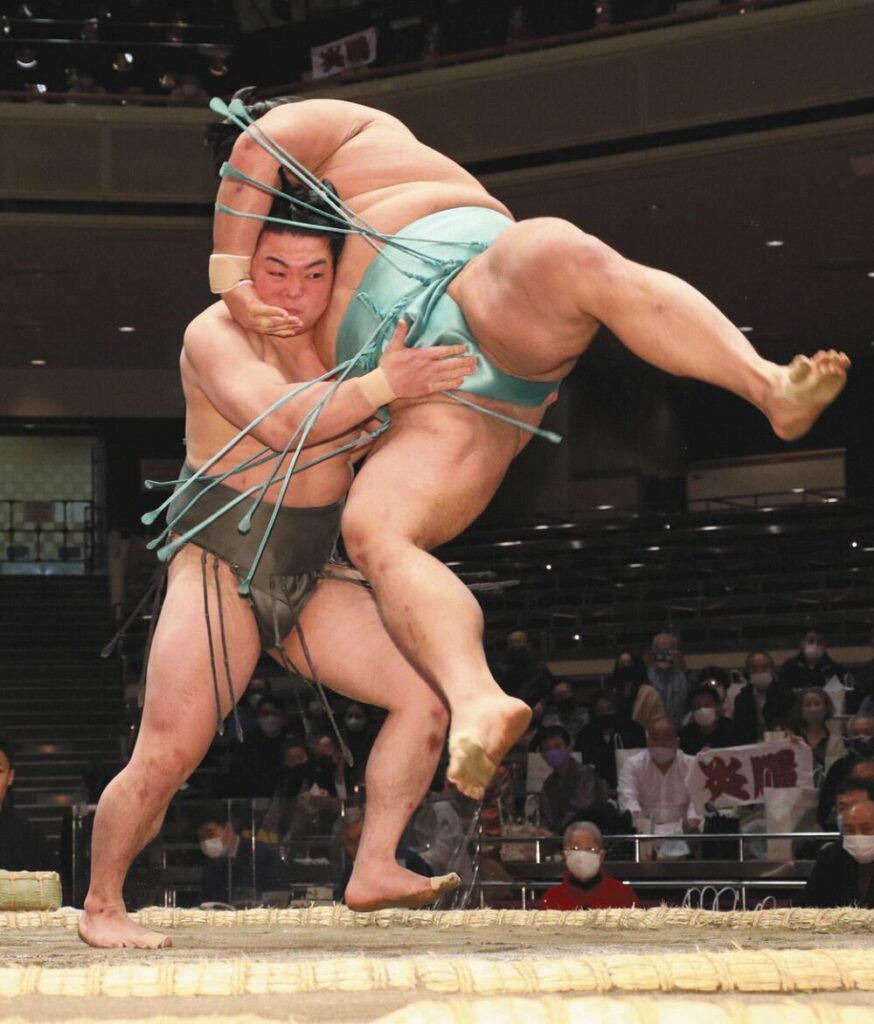
1-4. Sumo match progress.
1.Yobidashi: Yobidashi(ring announcer) who has moved up to sumo ring calls out one rikishi from the east and one from the west who will fight the match.
In addition to yobiage(calling out rikishi’s name), they have many other jobs, such as dohyo(ring) maintenance, drum beating, and taking care of rikishis, gyojies(referees), and umpires.
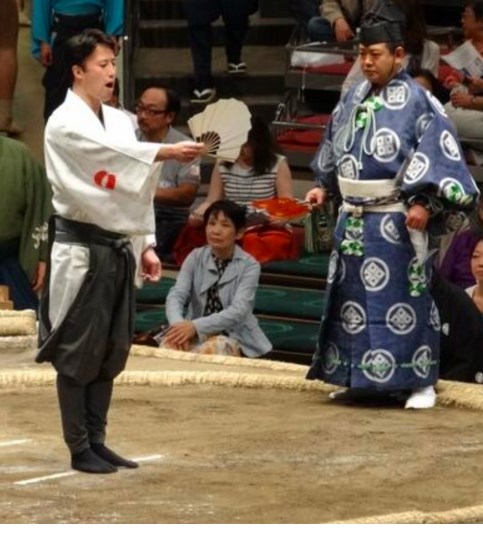
2.Shikofumi(stomping): The called rikishi do a shikofumi on the sumo ring. He raises his each leg highly and stomp the ring. It also means to crush the evil one on the ground.

3.Chikara mizu(power water): The rikishi receives water in a hishaku , a ladle, from the rikishi and gargles. This is called chikara mizu, a power water, and is meant to purify the body.
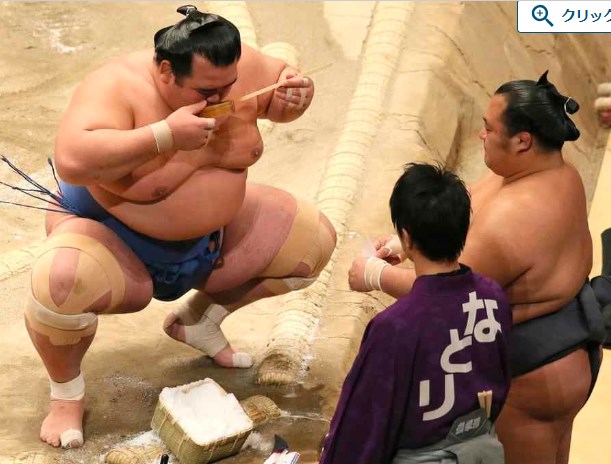
4.Shiomaki(Throwing a handful of salt over the ring)
Salt in a basket is picked up and sprinkled on the sumo ring by the two rikishis. This is meant to purify the body and prevent injury.
The amount of salt sprinkled varies from rikishi to rikishi. Some rikishi sprinkle a palmful of salt, while others sprinkle a little with three fingers.
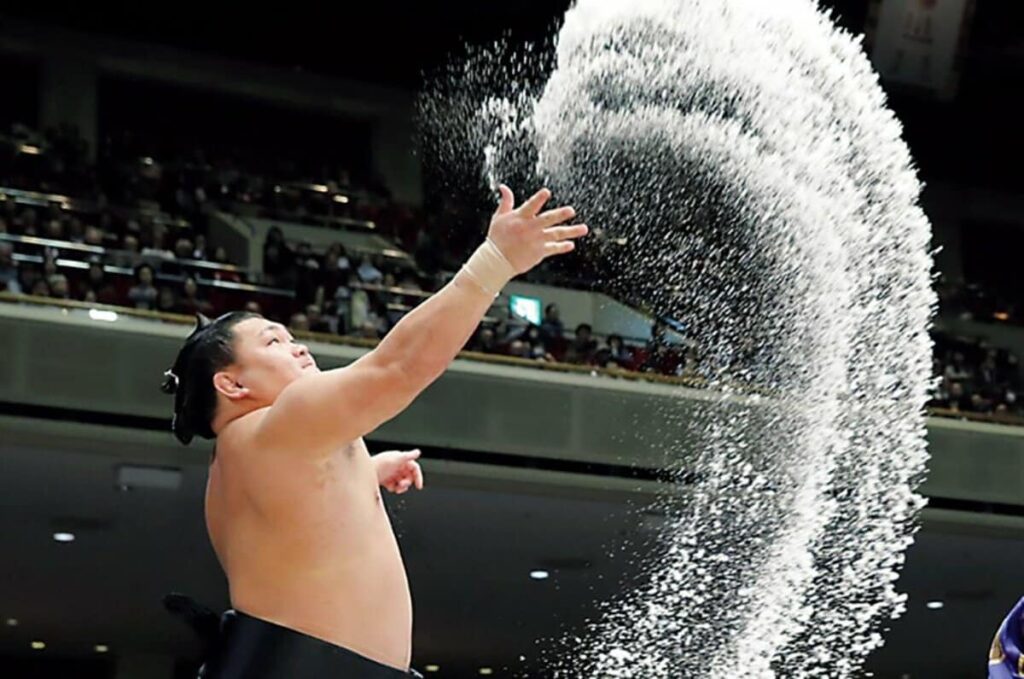
5.Chiri wo kiru: The wrestlers rub both palms together at the entrance to the sumo ring, then open their arms to the left and right, palms facing first upward and then back downward.

This is called “chiri wo kiru. The word “chiri” is an abbreviation of “chiri-chou-zu,” which means “dust and water.”
It is believed to have originated in the old days when sumo wrestlers used grass to cleanse their hands when they wrestled outdoors, and it also indicates that they had no weapons of any kind.
6.Shikiri( ceremonial rountines to get prepared to fight): The rikishi proceed to the center, they raise each leg highly and stomp the ring again. Then they bend down and put their hands on the ring, poised for charging.
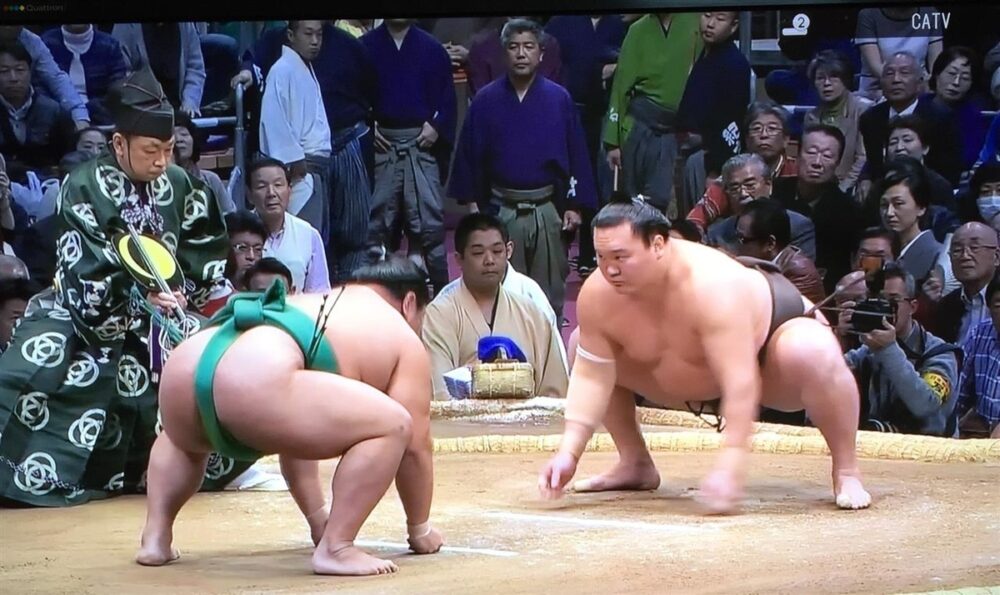
While repeating ‘shikiri’, ceremonial rountines to get prepared to fight, he gradually gets the best timing to explode his power against his opponent.
This movement is called shikiri.
Usually, from the sonkyo (formal crouch) posture, the fighters slowly stands up, then bends down again while maintaining eye contact, lowers his upper body, puts one hand on the ground, and when both agree, puts the other hand on the ground before striking the opponent.
7.Tachiai(Initial charge): The match begins when the two rikishis are in sync. This moment is called tachiai (initial charge); the gyoji (referee) does not signal the start of the match.
The timing of tachiai is implicit in both rikishis, and if they are not in sync with each other, they will be re-arranged. The time is limited from calling the ring name by yobidashi to tachiai by wreslers rank.
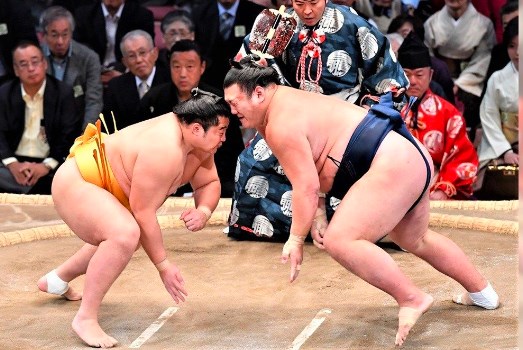
8.Hantei: In sumo, two rikishi fight in the sumo ring, and the winner is the one who is taken the opponent out of the sumo ring, or the one who makes the opponent’s body parts other than the soles of his feet are covered with soil inside the sumo ring. The winner is judged by gyoji(referee). The winner receives a prize money, if any.
9.Shinpanin: The match between the two is watched by five shinpanin(umpires) (ex. rikishi) under the ring.
When there is doubt about the gyoji’s decision, the five umpires enter the ring to discuss the match and its outcome. If necessary, they communicate by radio with the recording staff in a separate room.
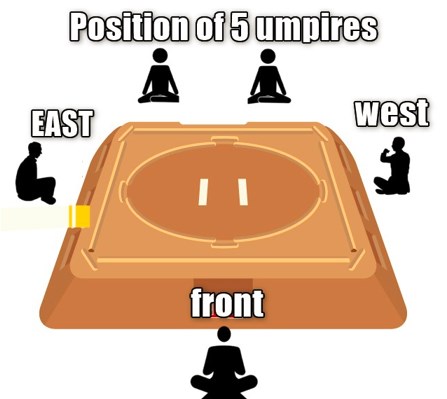
After the discussion, the two rikishis separate and bow, and the losing rikishi leaves the ring. The winning rikishi crouches down at the edge on the sumo ring and is announced as the winner by the gyoji and receives a prize money, if any.
The winner makes a three-cutting motion(“tegatana wo kiru” in Japanese) when he receives the prize money. The tegatana means a hand sword.
According to the Kojiki, Japan’s oldest mythological and historical book, this action is meant to express gratitude to the three gods who were the source of all things when Japan was created: Amanominakanushinokami, Takamimusuhinokami, and Kamimusuhinokami.

10. Yumitorishiki Ceremony (Bow-twirling ceremony)
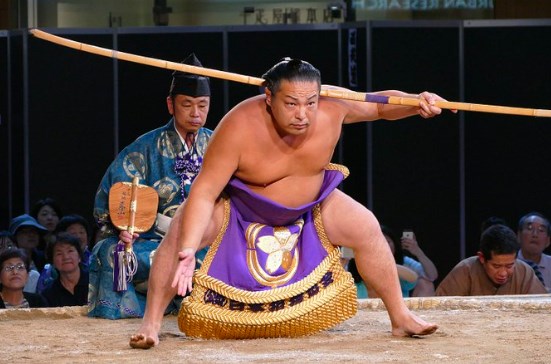
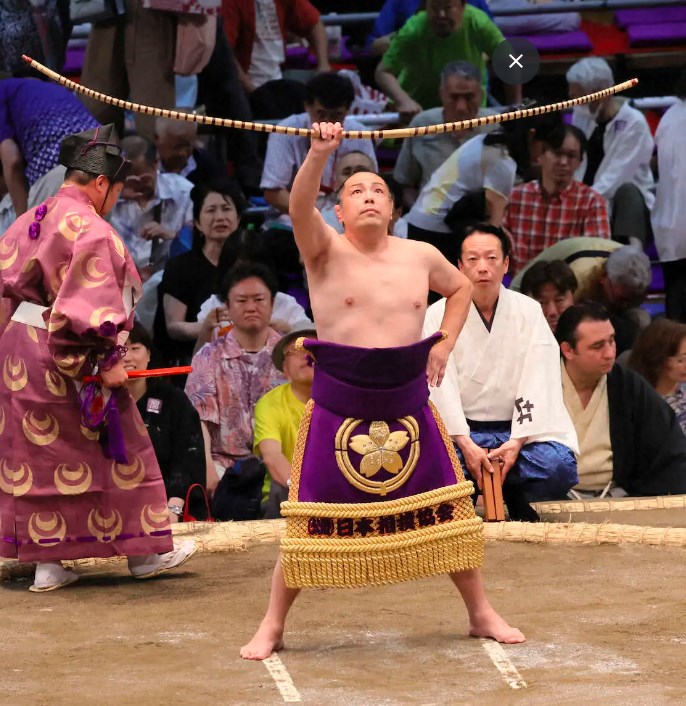
After the final match of each day, a rikishi twirls his bow in a dohyo(ring) at the six grand sumo tournaments held each year.
This is called the yumitorishiki ceremony. Originally, when the winning rikishi of the tournament received the bow as a prize at the end, he expressed his joy and danced with the bow.
Recently, it has become a ceremony to honor the winner of the last match of the day. A rikishi who knows the etiquette of the sumo world performs the twirling of the bow for the winner.
Method of the Yumitorishiki Ceremony
- The rikishi in charge of the bow-twirling ceremony(performer) stands in front of the stands in front of the seat on the south side of the dohyo.
- If the rikishi from the east wins, he steps on the ring from the east. If the rikishi from the west wins, he steps on the ring from the west.
- The performer receives the bow from the gyouji.
- The performer the bow in one hand, rotated over his head and swung in a figure-eight motion from side to side.
- The performer stomps with the bow on his shoulder.
These movements have a meaning.
The bow is used to purge the ring of evil spirits, and the stomps are used to cleanse the ring and prepare it for the next day’s sumo match.
Let’s take part in the ceremony.
When the performer stomps on the dohyo, the audience shouts “Yoisho!” at the same time.
You can also shout “Yoisho!”, and you will feel like a sumo connoisseur.
1-5. Kimarite(winning tricks)
There are seven types of basic sumo techniques, 82 in all.
①Tsuki-dashi(Pushing out):
A technique in which a wrestler thrusts the opponent’s chest or shoulder with the palm to forcefully push the opponent out of the ring. It requires both the strength of the hands and a sharp start. Ranked No. 10 in the list of most popular techniques.
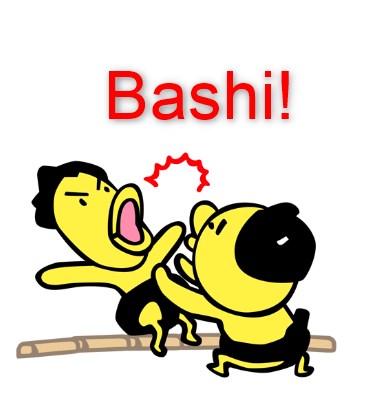
②Tsuki-taoshi(Thrusting down):
A technique in which the palm strongly thrusts the opponent’s body, regardless of whether the opponent is inside or outside the ring, to knock him down. If the opponent does not fall but is outside the ring, it becomes a “tsuki-dashi. Ranked No. 20 in the list of most popular techniques.
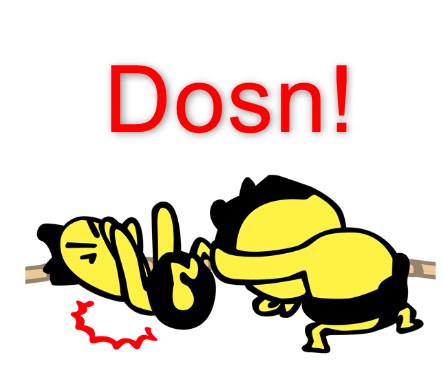
③Oshi-dashi(Pushing out):
To push an opponent out of the ring by placing both hands or one hand on the opponent’s armpitside or chest. *The thumb and the other four fingers must be held in a Y-shape. No. 1 on the list of most common techniques.
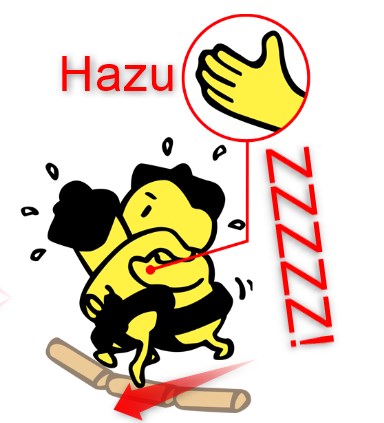
④Oshi-taoshi(Pushing down):
To win by pushing down the opponent’s armpitside or chest with both hands or one hand. If the opponent does not fall down but goes out of the ring, it becomes “oshi-dashi. This is ranked No. 8 in the list of most popular techniques.
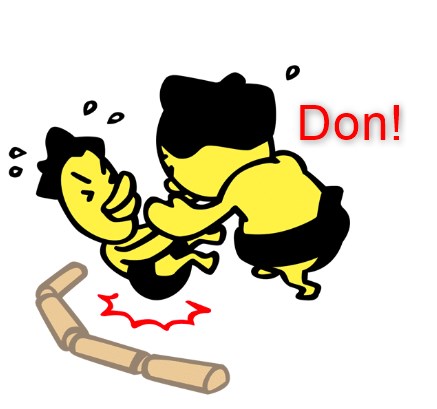
⑤Yorikiri(Forcing out): To advance forward or sideways with the opponent in close contact with the body and push the opponent out of the ring. It is ranked No. 2 in the list of rules.
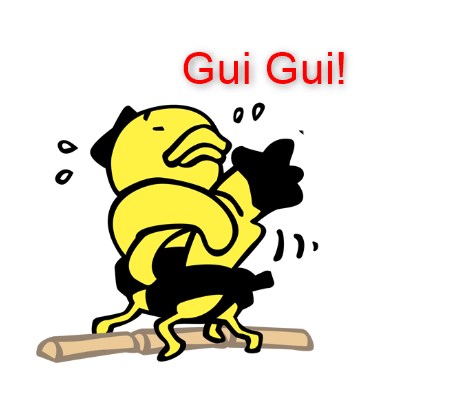
⑥Yori-taoshi(Frontal crush out) :
To advance forward while keeping close contact with the opponent. The fighter, keeping his body close to the opponent, leans toward him and knocks him down to win the bout. Ranked 6th in the list of Deterministic techniques.
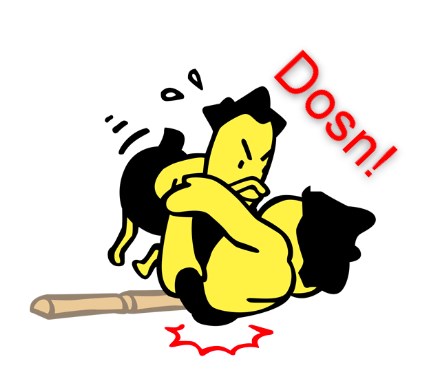
⑦Abise-taoshi(Backward Force Down):
When an opponent body is bent backward like a bow or crumples his waist to a low position, you must put all your weight on him to crush him and win the match. It is ranked No. 22 in the ranking of the most effective techniques.
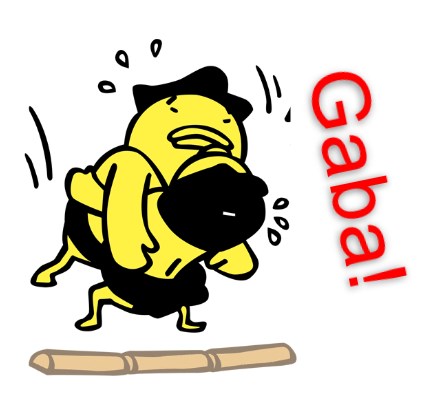
Based on the above 7 basic techniques, there are also throwing techniques, kake-waza, and twist techniques, etc.
Kake-waza means that one leg is placed in the opponent’s inner thigh, and throws the opponent while jumping up. It is used as a reversal technique to jump up and throw the opponent’s outside leg from the inside.
There are 82 techniques in total.
Pictrure source: Japan Sumo Association
1-6. Dohyo (ring)
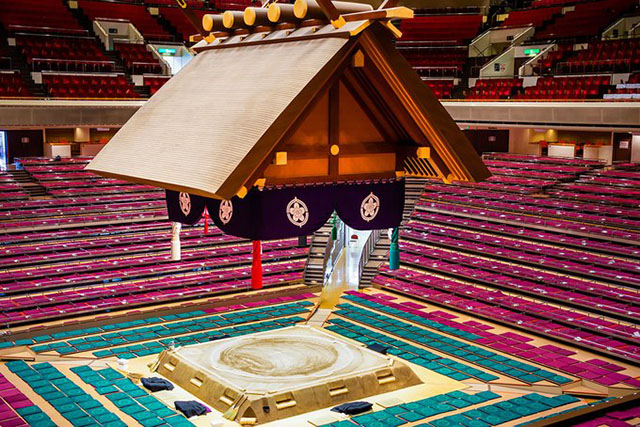
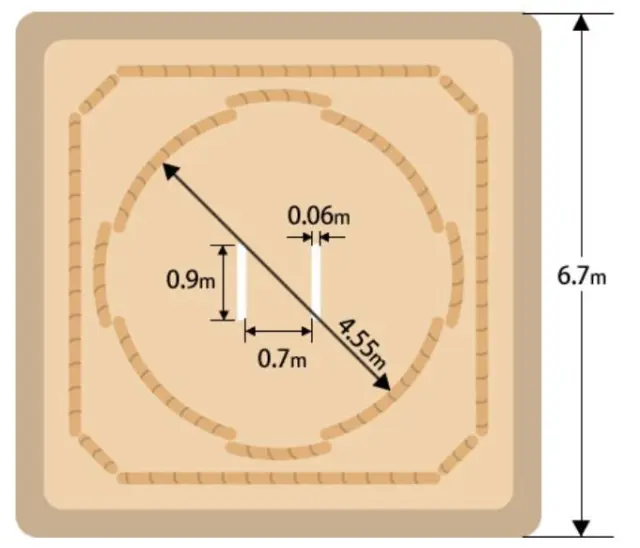
The place where two sumo wrestlers fight is called the Dohyo(ring). The dohyo is made of clay.
The size is a square with 6.7 meters on each side. A circle with a diameter of 4.55 meters is made on the square. The height is 66 cm.
The amount of soil required for this is about 35 tons, and it takes about 45 people working together for about three days. No machines are used, and the work is done entirely by hand.
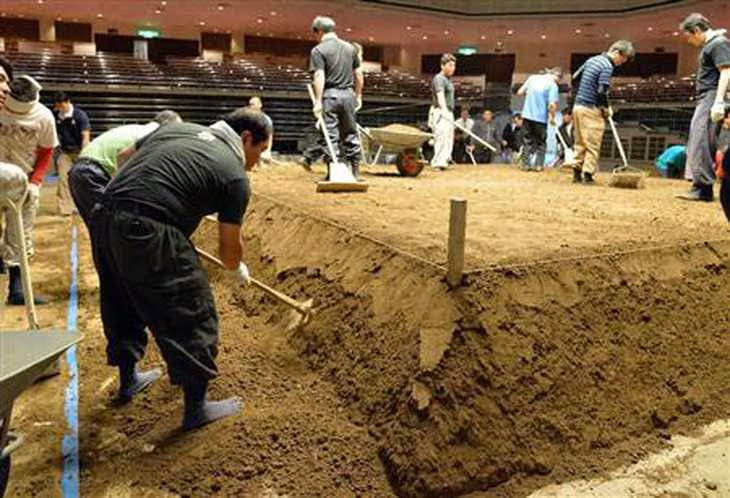
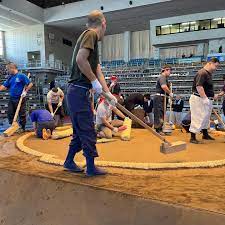
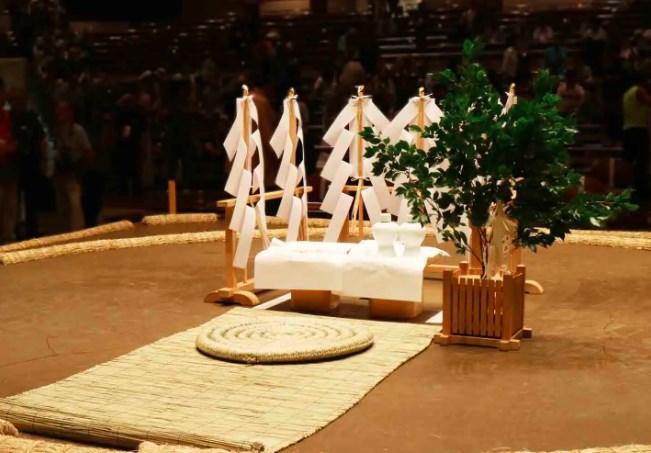
This work is called dohyo-tsuki.
The reason why the size figures are so semi-complete is that the original Japanese size standards were converted to the metric system.
2. Dohyo-iri (ring ceremony)
The Dohyo-iri (ring-entering ceremony) was originally a Shinto religious shrine event. It was also a ritual to pray for peace and a good harvest.
In the Edo period (1603-1867), Rikishi from the Ozeki rank down to the Makushita rank took turns in this ritual, which also served as an exhibition, showing all the wrestlers’ faces.
There are three main types of dohyo-iri:
- Yokozuna Dohyo-iri
- Makuuchi Dohyo-iri
- Juryo Dohyo-iri
②and③are performed same way.
2-1. Yokozuna Dohyo-iri
There are the following scenes of Yokozuna Dohyo-iri ceremonies.
- Dedication Dohyo-iri;
The first ceremony held after a promotion to Yokozuna is the dedication Dohyo-iri ceremony, which takes place at Meiji Jingu Shrine (Tokyo). - When a new Yokozuna is born, a dedication ceremony is held at Tomiokahachimangu Shrine (Tokyo) and Nominosukune Shrine (Tokyo), where there are monuments to Yokozuna wrestlers, as well as an inscription ceremony on a Yokozuna monument.
- The Dohyo-iri ceremony is held every New Year’s Day at Meiji Jingu Shrine.
- The ceremony is also held at the Ise Jingu Shrine (Mie prefecture),
- Izumotaisha Shrine (Tottori pref.), Yasukuni Jinja Shrine (Tokyo), and other shrine facilities that are usually used for the spring tournaments, as well as at other national events and functions.
- When a new sumo stable is built or an existing stable is relocated, it is customary to celebrate the opening of the Dohyo by inviting the current Yokozuna. If there is a Yokozuna in the stable, that Yokozuna is invited, but if not, a Yokozuna from outside the stable may be invited.
- When a former Yokozuna retires, he performs his final Yokozuna Dohyo-iri ceremony before the topknot-cut ceremony.
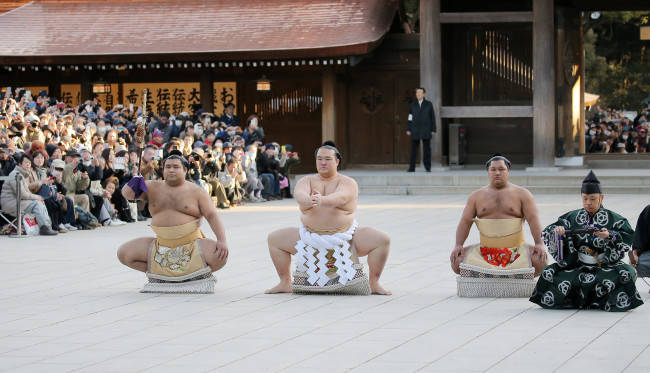

2-1-1. Two Types of Dohyo-iri
Currently, two katas are believed to remain as Yokozuna Dohyo-iri kata.
Although there is no firm definition of these kata, they are generally performed as follows.
Kata is pronounced gata when connected to the previous word.
- Unryu gata(type): After the Yokozuna stamps on the ring, he raises himself with his left hand on his side and his right arm out in front of his right side, then gradually raises himself.
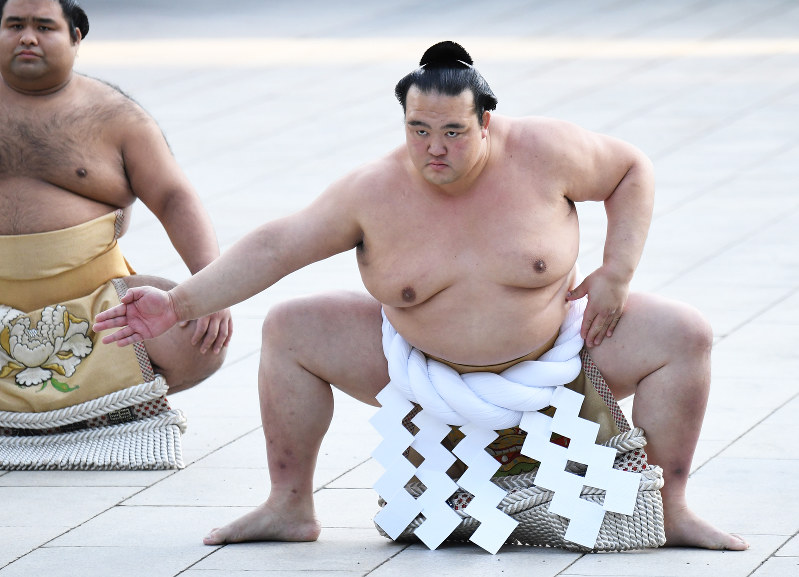
- Shiranui-gata(type): After the Yokozuna stamps on the ring, he raises himself with his both arms outward and forward, and then gradually raises himself.
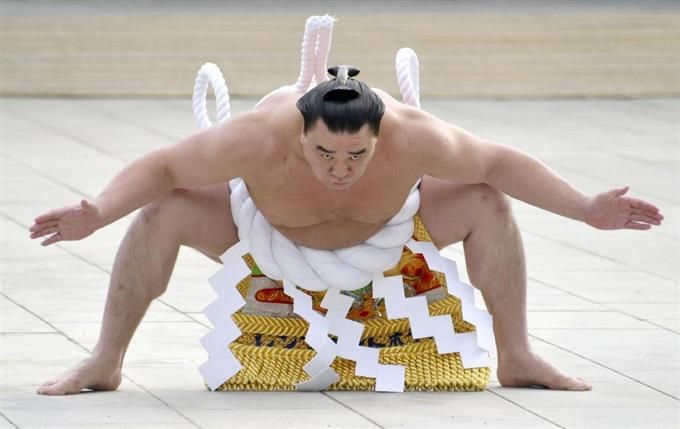
2-1-2. Tachimochi(sward holder) and Tsuyuharai(walking leader)
When a Yokozuna performs the Yokozuna Dohyo-iri ceremony, he is accompanied by the following two men.
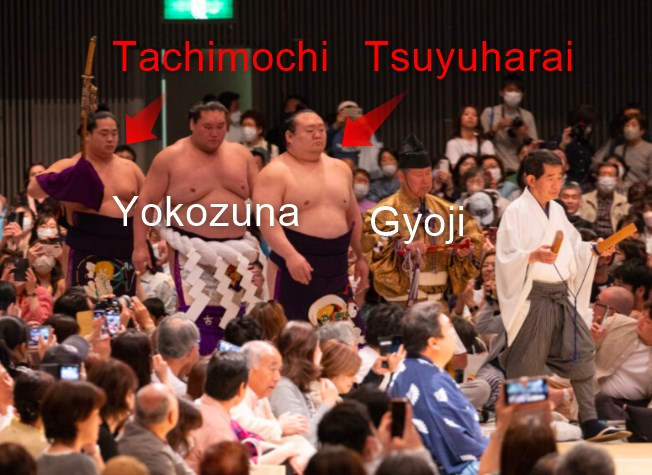
- Tachimochi:
The tachimochi Rikishi accompanying the Yokozuna holds a Tachi(sword) in his right hand. This is said to be a remnant of the practice in samurai families of having the sword carried by a peasant.
In the actual Yokozuna Dohyo-iri ceremony, only the scabbard of the sword is carried.The real sword and the sword scabbard are prepared in pairs, and the sword blade is usually kept by the Yokozuna himself. - Tsuyuharai:
Tsuyuharai is an old Japanese term for a person who walks in front of a nobleman and leads him. During the Yokozuna’s Dohyo-iri ceremony, the Tsuyuharai Rikishi walks to the ring to lead the Yokozuna. - Ward origin of Tsuyuharai:
The word “Tsuyu-harai(dew-dispelling)” was first used in the Heian period when kemari(football game) was played as a court event.
Before a game, the players would kick the ball against the surrounding trees to remove dewdrops from the trees, and the person who did this was called a Tsuyu-harai.
In later times, at night or early in the morning, when groups of people were moving through grasslands and fields with long and shady grass, they would have the lower-ranking members of the group walk ahead of them to remove the dew and rainwater from the grass.
The higher-ranking members of the group would not have to get their clothes wet. The act or the person doing it is called a Tsuyu-harai.
2-1-3. Meaning of Yokozuna
Yoko of Yokozuna means side, and zuna means rope.
The Yokozuna rope has the following features.
The materials used to make the Yokozuna rope are hemp, cotton, and copper wire, which are rubbed together with rice bran.
The hemp is thickened in the center, and copper wire is inserted in the loop at the back to maintain a three-dimensional shape.
Hemp is generally believed to have the power to ward off evil spirits.

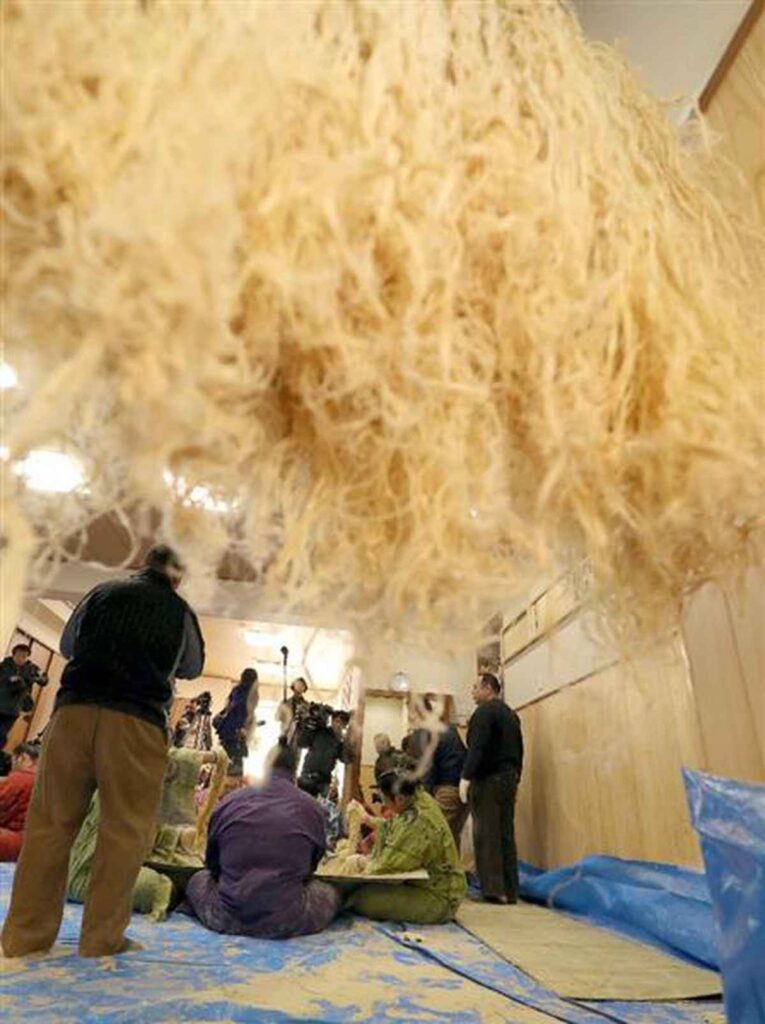
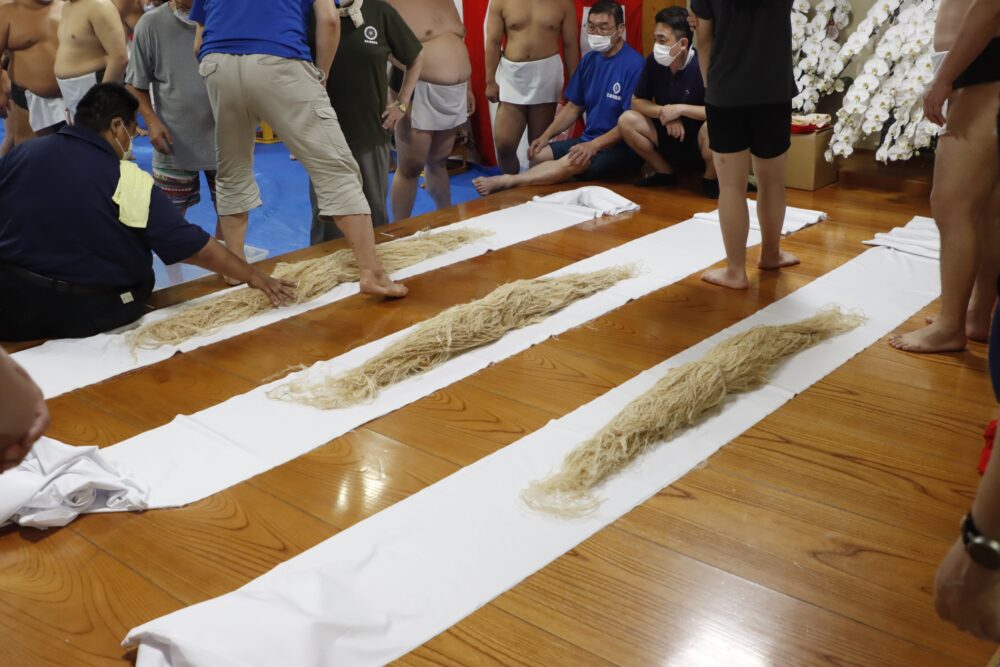
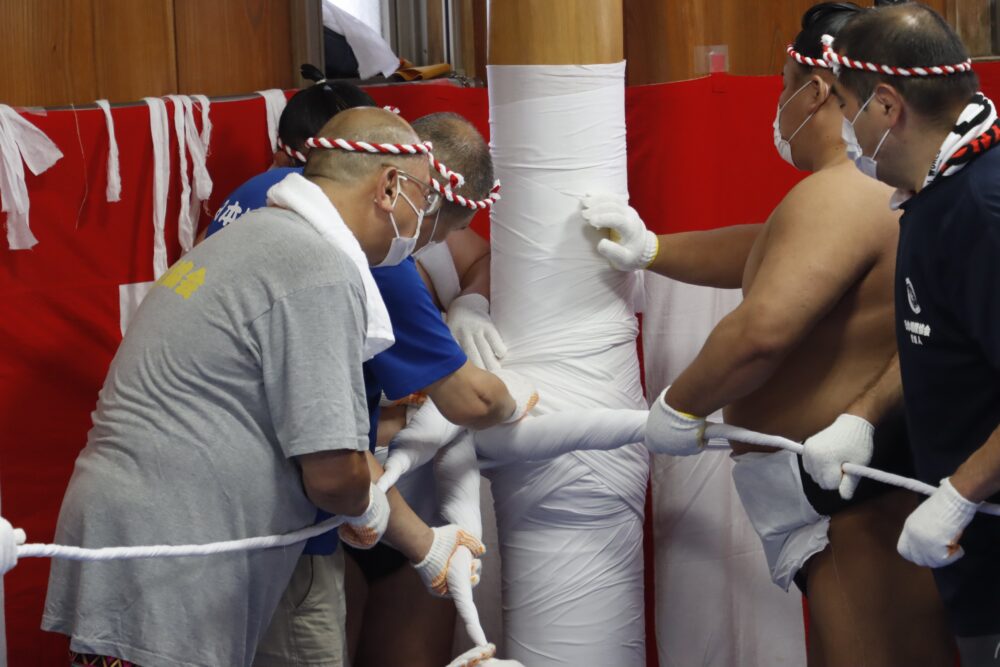

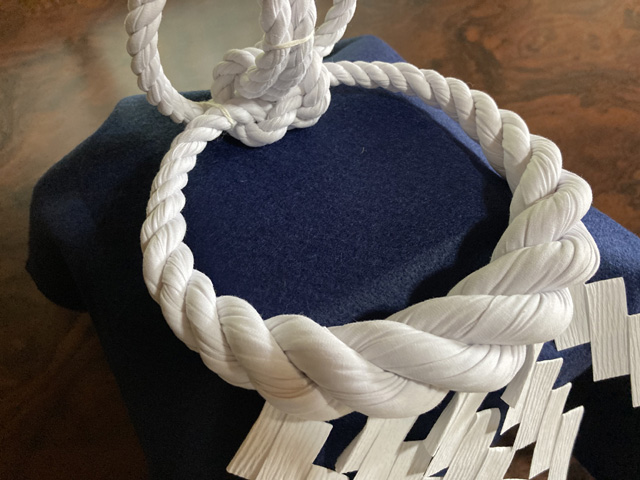

2-2. Makuuchi Dohyo-iri
During the makuuchi rikishi’s dohyo-iri(ring-entering ceremony), all rikishis put on their kesho(make-up) mawashi and step on the dohyo(ring) to make their appearance.
- All rikishis gather at the end of the aisle.
- The gyoji(referee) leads them into the ring in order of rank.
- When the rikishi steps on the ring, their names, hometowns, and stable names are announced.
- Each rikishi faces outward until all the rikishis have stepped on the ring, then turns inward when the last rikishi steps on
- When all the rikishis are on the ring, they clap their hands, raise their right hand, pick up their kesho-mawashi, and raise both hands.
- This is a simplified version of the shikofumi(stomping) and seriagari. Originally, the raising of the hands was done lightly with the elbows bent to indicate that the rikishi had no weapons, but in recent years, rikishi have tended to raise their hands in the air as if in a banzai gesture.
- After completing the ceremony, rikishi return to the aisle.
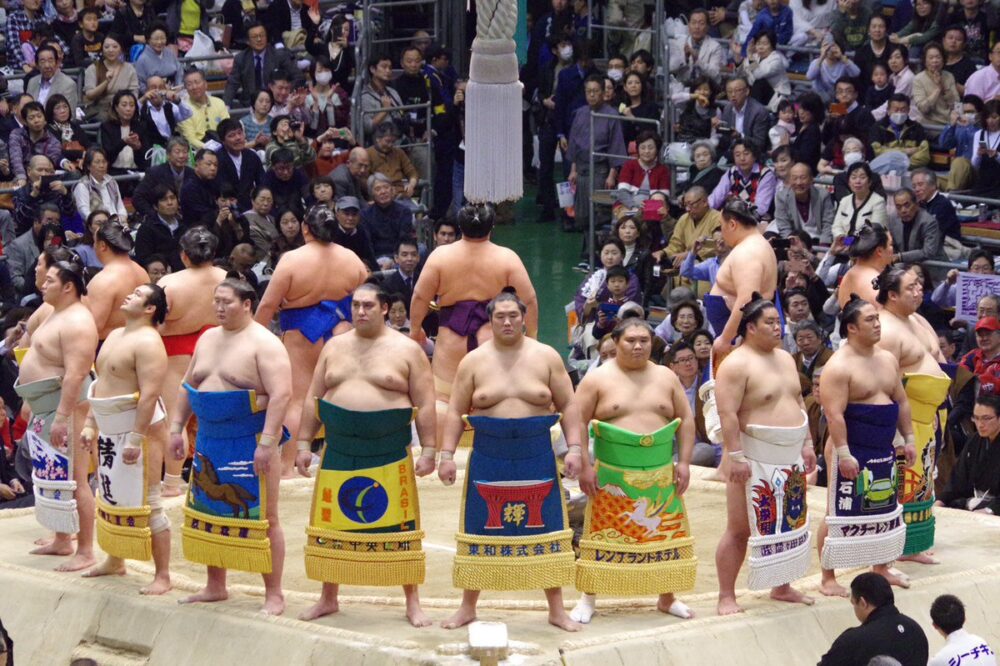
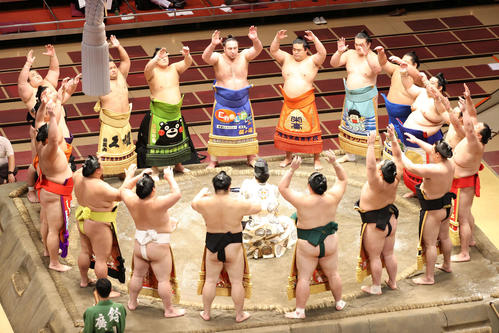
3. Tenran-zumo (Sumo performed in imperial presence)
The Emperor’s viewing of the Grand Sumo Tournament is called Tenranzumo. It is customary for this event to be held on the middle day (Sunday, the 8th day) of the January tournament in Tokyo every year.
All Yokozunas and other top-ranked rikishis, as well as their stablemasters, who are also board members of the Japan Sumo Association, greet the spectators at the main entrance of the Kokugikan.
The President escorts the Emperor and Empress to their seats. The President remains in their seats until they leave the hall, acting as a commentator.
In 1960, the Emperor and Empress began to watch the tournament together. In 2020, the Emperor, Empress and their daughter, Princess Aiko(right), also attended the tournament.
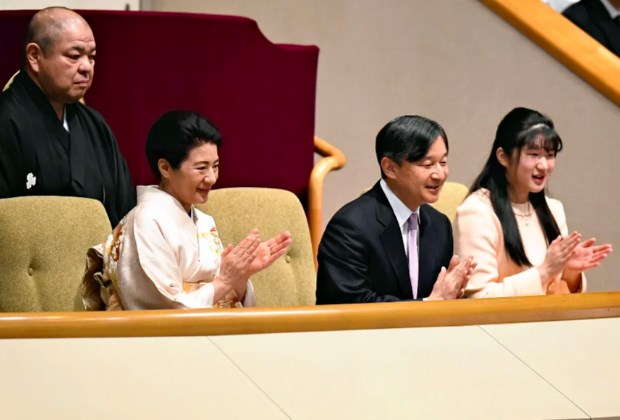
4. Rikishi (Sumo wrestler)
A professional sumo wrestler is called Rikishi. Strictly speaking, a rikishi is a sumo wrestler who belongs to a sumo stable, has a Shikona (ring name), is registered on the banzuke (ranking list), and participates in o-zumo.
Japanese people generally refer to rikishi as “o-sumo-san” for familiarity. In this case, “o” is a prefix for politeness.
Rikishis who belong to the Makuuchi and the Juryo divisions are also called Sekitori.
4-1. Banzuke (ranking list)
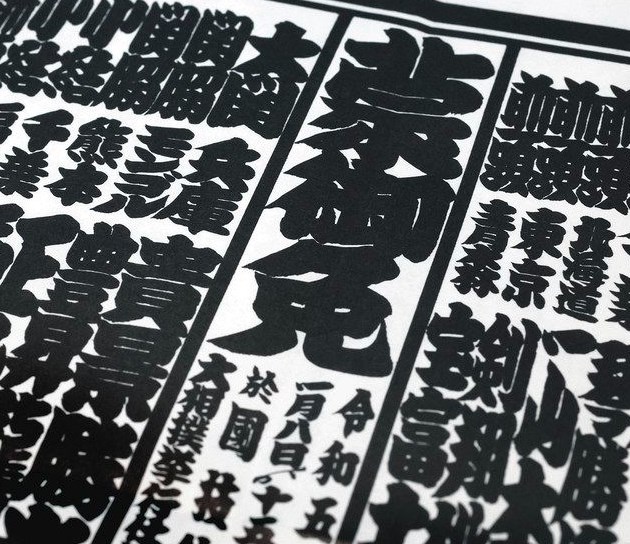
Banzuke(official ranking list) is a list of ranks of Rikishi, Gyoji(referee), and Toshiyori, written in the unique sumo script, with the letters becoming larger and bolder the higher the rank and smaller and thinner the lower the rank.
“Toshiyosi” refers to former rikishi, now officers of the Japan Sumo Association, stablemasters, and stable trainers.
The Gyoji writes the Banzuke in sumo script. It is called “Motogaki”.
The ranks of Rikishi for the tournament are decided at the Banzuke organization meeting held three days after the grand sumo tournament’s senshuraku(the last day).
The Gyoji writes the banzuke with a brush on a piece of paper 110 cm long and 80 cm wide. When finished, it is reduced to about one-quarter of its original size (58 x 44 cm) and printed.
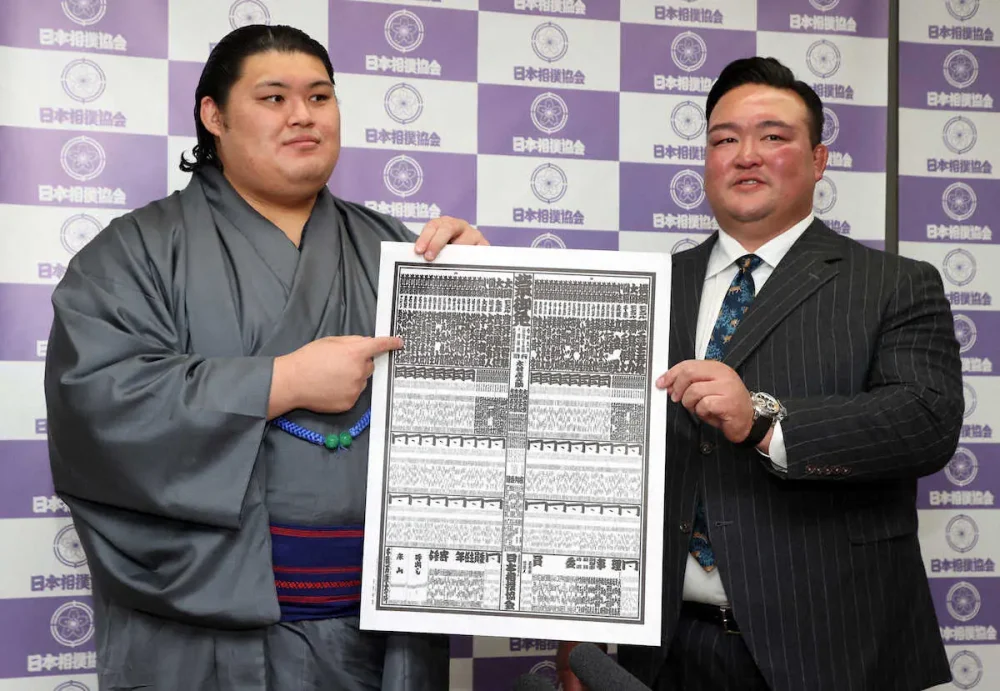
4-2. Six divisions of ranking
The rikishis are classified into the following six divisions according to their performance in the immediately preceding grand tournament.
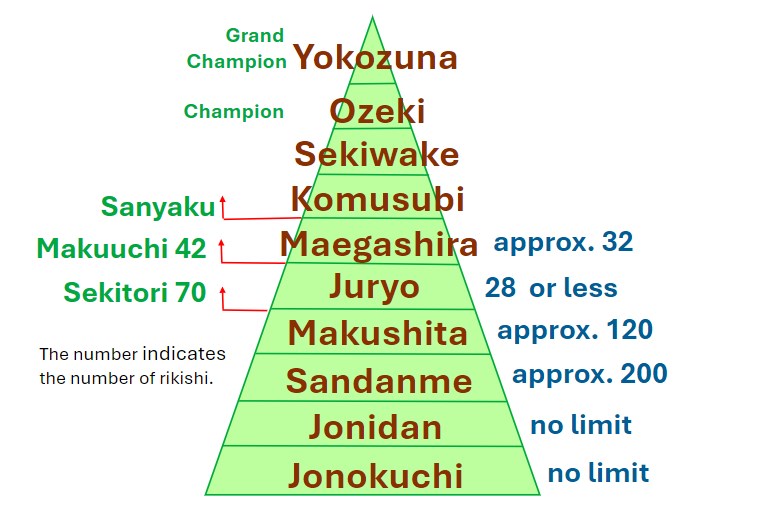
- Makuuchi division: Makuuchi is the highest rank, with approximately 42 rikishis. This division is further subdivided into Yokozuna (grand champion), Ozeki (champion), Sekiwake (the third highest rank), Komusubi (the fourth highest rank), and Maegashira (rank-and-file wrestlers in the highest division).
- Juryo division: The second division includes 28 rikishis. The makuuchi and juryo ranks together are called sekitori. They are recognized as professionals.
- Makushita division:The Makushita division includes about 120 rikishis.
- Sandanme division: the fourth division includes about 200 rikishis.
- Jonidan division: the fifth division with about 200 rikishis.
- Jonokuchi division: the lowest division with about 50 rikishis.
4-3. Special Awards
Rikishis are awarded special awards, sansho (three special prizes) , for their performance in the tournament: Shukun sho(the Distinguished Service Award), Kanto sho(the Fighting Spirit Award), and Gino sho(the Technical Achievement Award).The sho means a prise in Japanese.
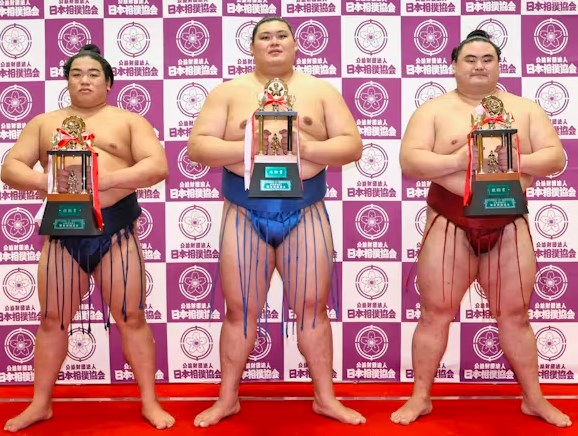
The amount of each prize is 2 million yen.
Each day, advertisers pay 70,000 yen (30,000 yen for the winning rikishi’s take-home pay) for each popular bout.
When a rikishi ranked in the hiramaku wins against a Yokozuna, he is awarded a Kinboshi (Gold star), and 40,000 yen is paid for each gold star. Kin means a gold, boshi a star.
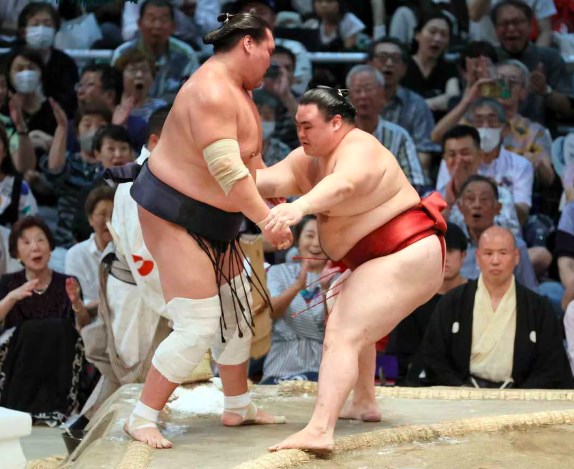
4-4. Kadoban
Kadoban means that a rikishi falls from his position when he has a losing record (loses 8 or more days out of 15) in the main tournament of sumo. It is usually used for a rikishi who is the reigning Oozeki.
4-5. Number of the Rikishis
The number of Rikisi on the Banzuke(official ranking list) for the Grand Sumo Tournament held in January 2024 was 599, falling below 600 for the first time in 45 years. The previous record was 943, set in the summer tournament of 1994.
4-6. Origin of Makuuchi
In the Edo period, when the Shogun went on a pleasure trip or an outing, a curtain(maku in Japanese) was drawn around the event. When the Shogun watched sumo matches, the curtain was also drawn so that the sumo match could not be seen from the surrounding area. The word “makunouchi” means inside of the curtain, and this became the makuuchi.
4-7. Origin of Juryo
Juryo is a name derived from the Edo period when makushita division rikishi whose annual salary was more than juryo were treated as professional sumo wrestlers. Ju of juryo means ten, and ryo is a unit of money at the time. Rikishis who belong to Juryo were treated as a sekitori.
Unlike the Makushita division, the Juryo division has a fixed number of members, 14 each for the east and west. Therefore, the number of people who can be promoted from Makusita in the next grand tournament depends on how many seats are left vacant in the Juryo after the grand tournament.
4-8. Smallest Sumo Wrestler
Today, Midorifuji (26) in the Isegahama stable is the smallest and lightest of the Makuuchi Rikishi, 1.71 m tall and 117 kg, but his commitment to the ring is not light.
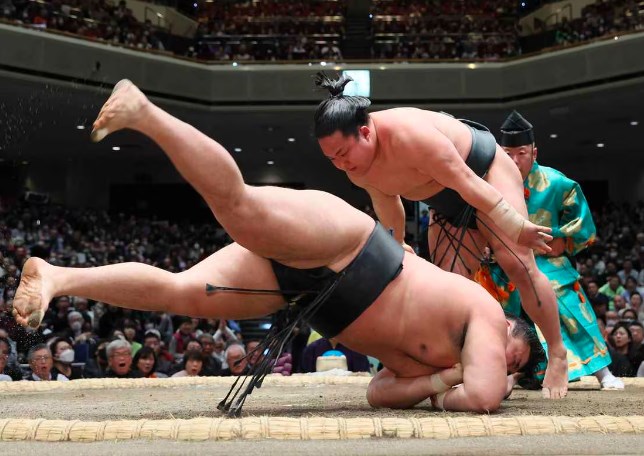
Fujimidake is said to be the smallest Rikishi in history. Although he was only 165 cm tall and weighed 71 kg, he repeatedly won opponents larger than himself.
In particular, on the 6th day of the May 1905 tournament against 18th Yokozuna Taiho, he was applauded for his impressive draw against a 30 cm height difference and 60 kg weight difference (at that time, there were two types of draws in addition to win and lose), and was considered one of the most popular Rikishi. The year before, in 1904, he fought the 22nd Yokozuna Tachiyama to a draw.
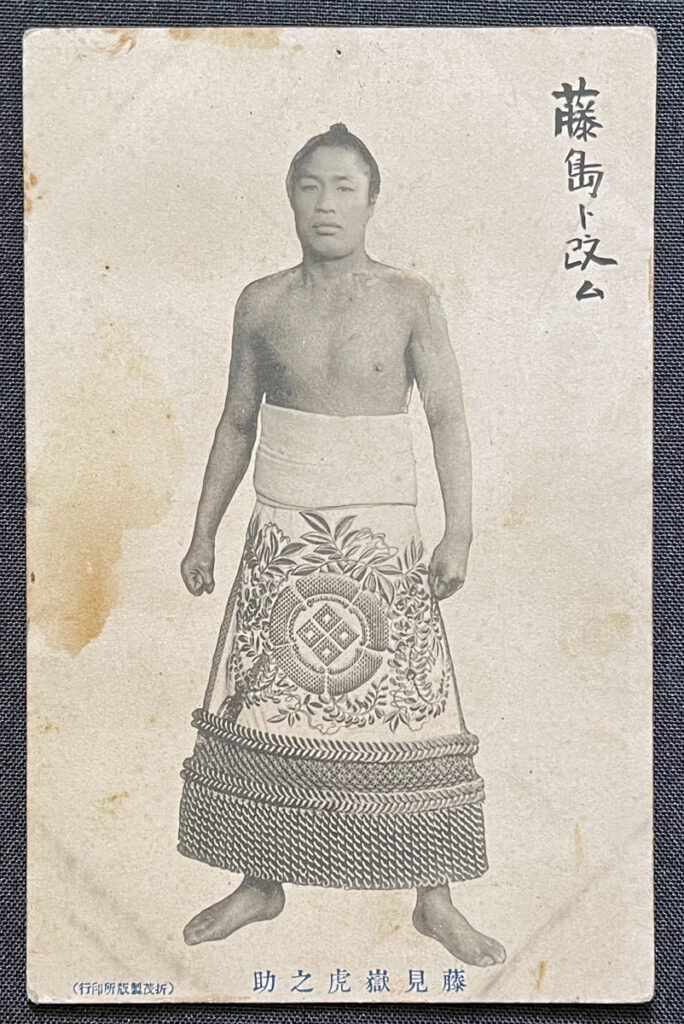
4-9. Average weight and Tall
According to the Japan Sumo Association (August 29, 2023), the average weight of Makuuchi Rikishi is 161.7 kg and that of Juryo is 158.3 kg. The average height of Makuuchi Rikishi is 184.8 cm, and the average height of Juryo is 182.8 cm.
Over the past 100 years, the average height has increased by about 10 cm and the average weight by about 60 kg; over the past 50 years, height has increased by 3.3 cm and weight by 33 kg.
The BMI (Body Mass Index) has increased by 43% over the past 100 years and by 21% over the past 50 years.
4-10. Heaviest Sumo Wrestler
The heaviest Rikishi during his active career was the Russian Makushita Aurora, weighing 273 kg(2011).
Currently, the heaviest Rikishi is the Japanese jJryo Yamamotoyama, weighing 265 kg.
4-11. Treatment
Rikishi are treated differently depending on their rank. Each rikishi competes in a honbasho six times a year and is promoted or demoted according to his performance.
The most significant difference between the makushita division and the juryo division is that juryo are paid a monthly salary by the Sumo Association. The current annual salary for a juryo is 13,200,000 yen. In addition, when traveling to provincial tour, juryo division members can use cabs to get from their lodgings to the venue, and can fly business class on airplanes.
4-12. Annual Pay
| Rank | Annual Pay JPY | Number of rikishi |
|---|---|---|
| Yokozuna | 36,000,000 | |
| Ozeki | 30,000,000 | |
| Sekiwake | 21,000,000 | |
| Komusubi | 21,000,000 | |
| Maegashira | 16,800,000 | 42 wrestlers |
| Juryo | 13,200,000 | 28 wrestlers |
| Makushita | 1,920,000 | |
| Sandanme | 1,320,000 | |
| Jonidan | 1,056,000 | |
| Jonokuchi | 924,000 |
4-13. Eligibility for Rikishi
- Both Japanese and foreigners must have completed compulsory education in their home country.
- Under 23 years old.
- However, if the applicant meets the eligibility criteria for makushita tsukedashi or sandanme tsukedashi, or if the board of directors approves a certain level of achievement in any sport, including amateur sumo, the applicant may take the test up to the age of 25.
4-14. Physique requirements
All applicants for Rikishi must meet the following physique requirements.
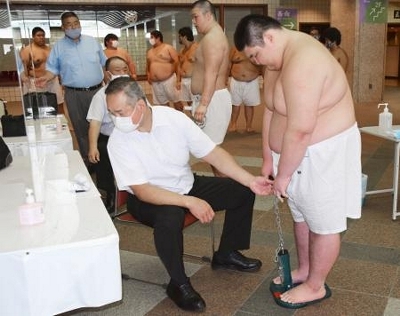
- Height 167cm or more, weight 67kg or more.
- For the March, which is known as the “place of employment,” only those who are expected to graduate from junior high school are required to be at least 165 cm tall and weigh at least 65 kg.
- Those who do not meet the above standards must take an athletic ability test prior in Tokyo, and if they are deemed fit enough, they will pass the test.
- For those approved for makushita tsukedashi(*) or san-danme tsukedashi(*), physical stature is not an issue.
(*)This is a privilege for former amateur and student wrestlers to step into the ring for the first time at the makushita or sandan-me ranks without having experienced previous sumo.
5. Mawashi (Sumo loincloth)
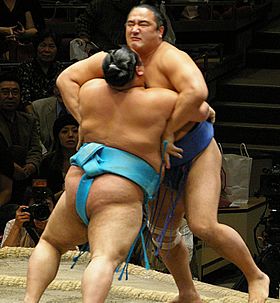
It is said that the origin of the mawashi of the sumo costume comes from the fact that sumo wrestlers used to wear loincloths, the underwear of the time, to prove that they did not carry any weapons such as swords when they wrestled.
In sumo, only one loincloth is used, and neither shoes nor gloves are used. The reason why it is called mawashi is because it is tightened by turning(mawashi in Japabese) it. Mawashi is also called “shimekomi.”
During the Edo period in Japan, men wore a loincloth as underwear, while women wore only a waistcloth without panty.

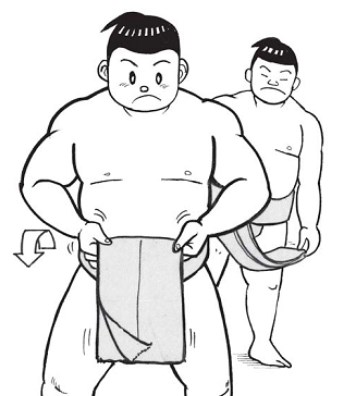
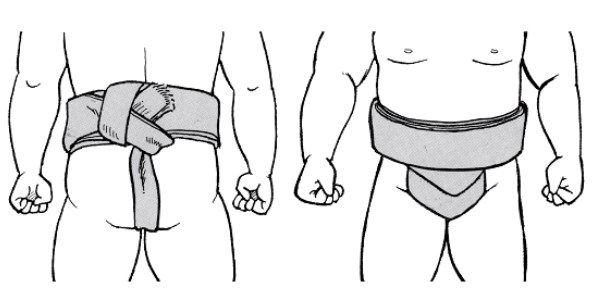
Pictrure source: Japan Sumo Association
5-1. Length of Mawashi
The length of the mawashi that sumo wrestlers fasten around their waists is about 6 to 7 meters for a Rikishi of average build and about 47 cm in width.
It is folded four times and wrapped around the body four to five times. It varies in length according to body type but maybe about 9 meters long and 80 centimeters wide.
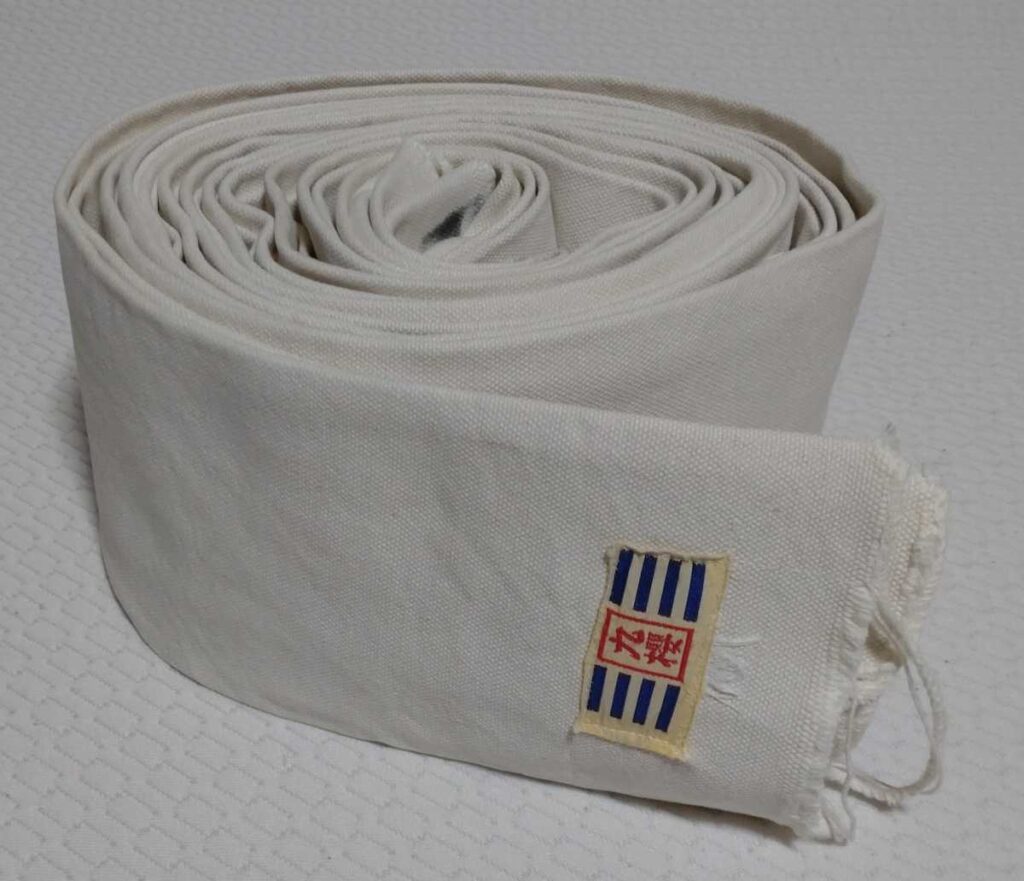
5-2. Kesho(decorated) mawashi.
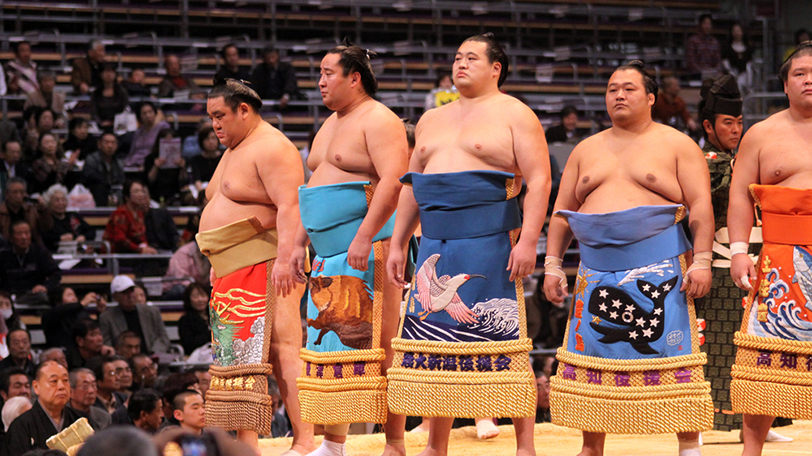
Kesho-mawashi (decorated mawashi) is a luxurious garment worn by sumo wrestlers when entering the ring.
This custom developed alongside sumo entertainment during the Edo period (1603-1867). During the period, sponsored rikishi (sumo wrestlers) were kept in reserve by feudal lords and competed with each other in sumo tournaments held in Edo and other places in Japan.
Sumo events were sometimes held to raise money for temples or shrines. At that time, there was no distinction between the mawashi used for matches and those worn at events, and it became popular to embroider the mawashi on a piece of cloth hanging down in front of the belly.
Later, rikishi began to wear kesho-mawashi with the sponsor’s name or emblem embroidered on it. It also came to serve as a status symbol for the rikishi.

Today’s kesho-mawashi are lavishly embroidered and decorated, using gold or silver threads and intricate embroidery techniques.
The materials used are mainly silk and other expensive fabrics. The kesho-mawashi is embroidered with the rikishi’s ring name, the emblem of his stable, and individual symbolic designs, reflecting the personality of the rikishi and his sponsor.
The mawashi is often gifted to the rikishi by sponsors and supporters and is considered an honor for the wrestler.
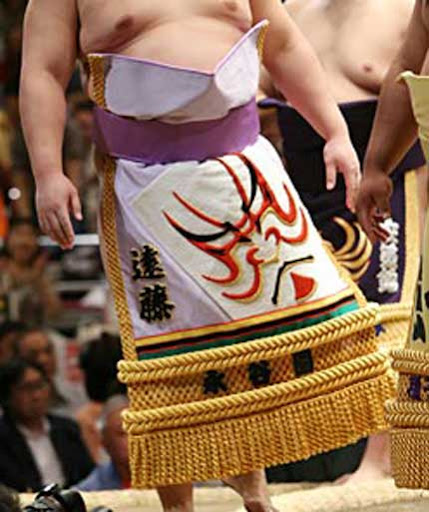
Today’s kesho-mawashi designs are diverse, ranging from traditional Japanese styles to more modern ones. The least expensive ones cost about 1 million yen, while some of the more elaborate designs can cost tens of millions of yen.
6. Calendar
6-1. O-zumo (grand tournament)
Six professional sumo tournaments(honbasho) take place every year: three in Tokyo, and one each in Osaka(central Japan), Nagoya(central Japan) and Fukuoka(west Japan).
Each tournament lasts for 15 days.
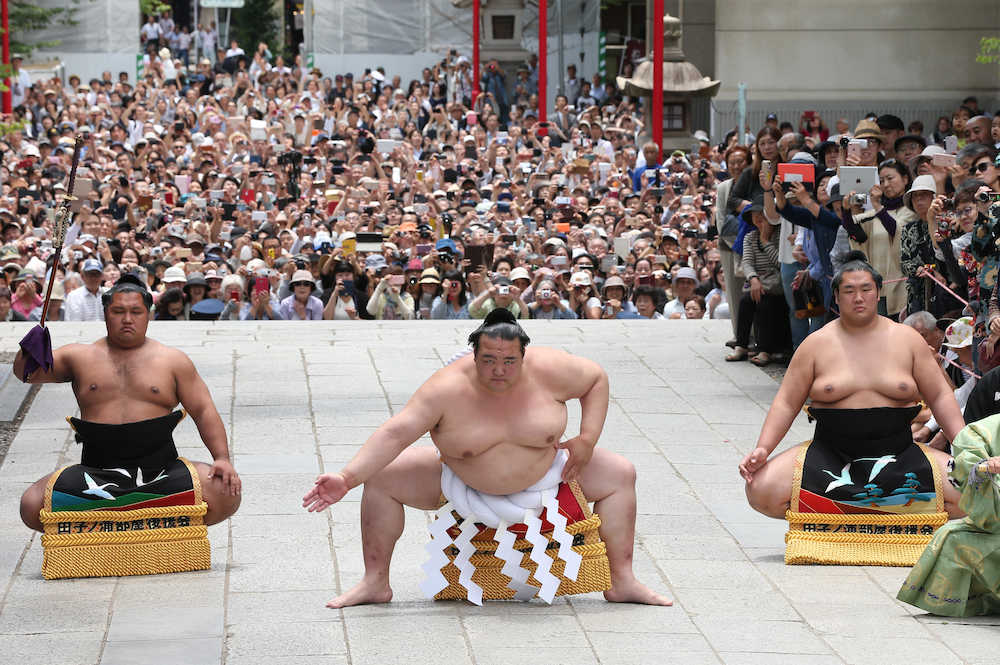
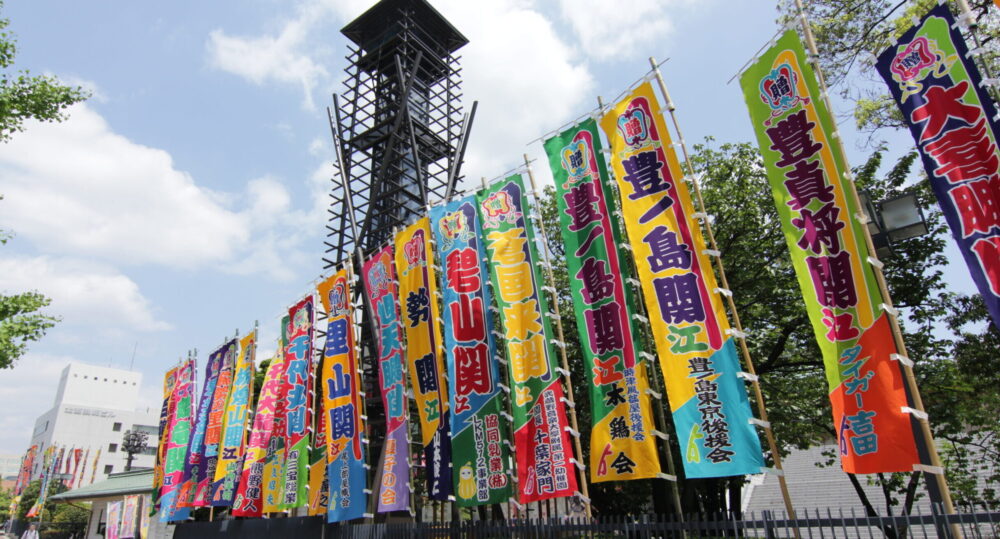
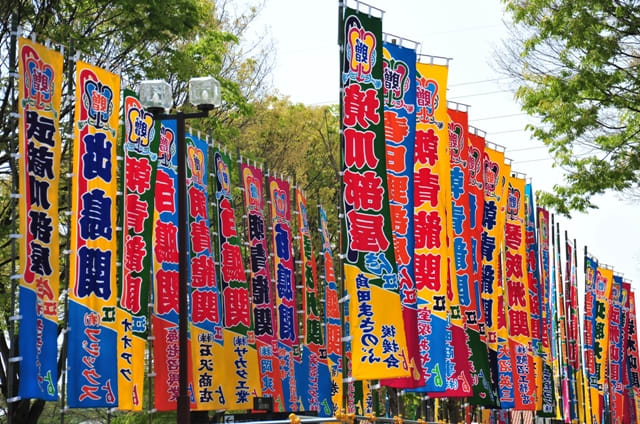
The honbasho (grand tournament) is broadcast live nationwide on television from 4:00 to 6:00 p.m. every day during the honbasho.
Most people work during this time and cannot watch sumo live on TV, so they watch the results of the matches on TV digest broadcasts starting at 23:00.
On holidays (e.g., Saturdays and Sundays), they can watch the live broadcasts. Or, they can record the live broadcast.
6-2. Jungyo (provincial tour)
In addition to honbasho, there is jungyo (provincial tour), which takes place four times a year in spring, summer, fall, and winter.
The main purpose of jungyo is to promote sumo. It is an important responsibility of the Japan sumo association to travel around the country and convey the appeal of o-zumo to local fans who are unable to attend honbasho matches.
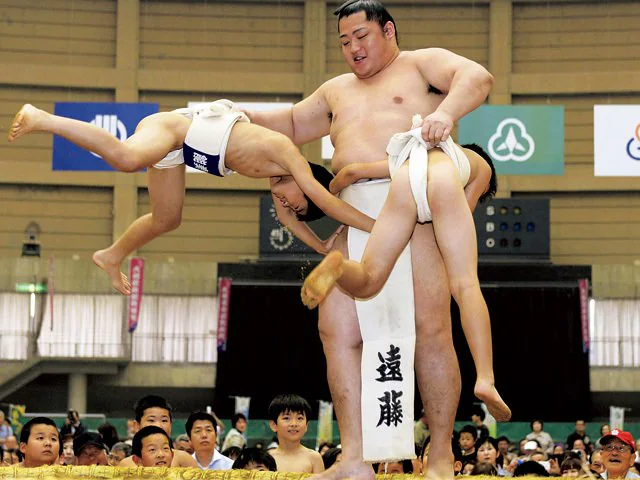
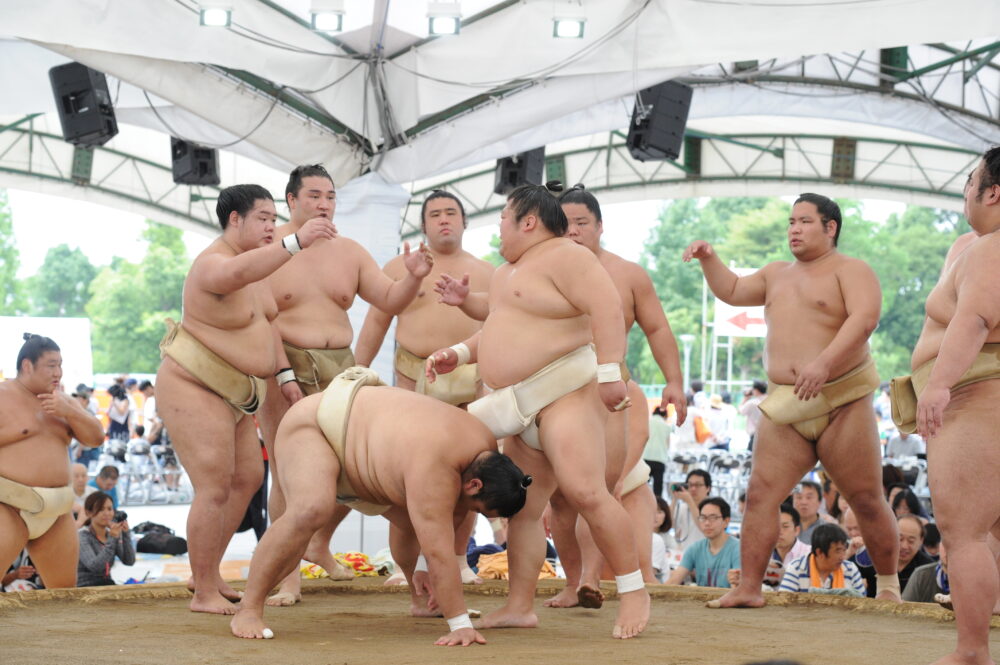

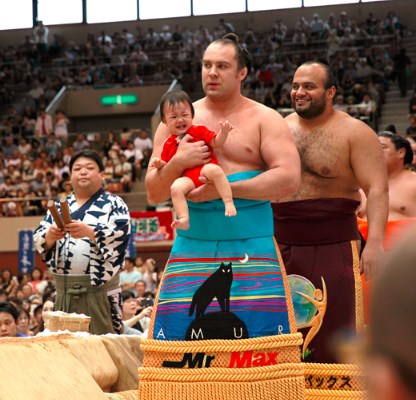
6-3. Sumo-Jinku (sumo-themed song)
An unusual entertainment in the world of sumo is called Sumo-jinku.
Sumo-jinku originated in the Edo period (1603-1867) and has been sung by sumo rikishis. Today, Sumo-jinku can be heard at the Provincial Tour and at the Ryogoku Kokugikan when sumo wrestlers retire.
Sumo-jinku is sung by rikishi on themes such as hometown pride, the state of the world, and the feelings of men and women.
Sumo-jinku is performed on the ring by five or six rikishis wearing kesho (make-up) mawashi on their provincial tours or when they retire from sumo.
Jinku, which is the basis of Sumo-jinku, is a type of Japanese folk song, a short song consisting of seven, seven, seven, and five syllables in Japanese.
Here is an example of sumo-jinku that is easy to understand for foreigners.
Title: Chanko-nabe
Supporters are called tanimachi
A fat rikishi is called anko-type
A muscular rikishi is called sop-type
Just the right physique is a medium anko-type
She and I are from the same hometown.
Sumo cuisine is called chanko-nabe(hot pot).
I’ll tell you why it’s called chanko-nabe.
Once upon a time, chanko-nabe was cooked by an old sekitori(sumo wrestler).
He had a bald head and a hachimaki, cooking chicken and fish.
When the young rikishi saw him…
Reminded him of his father in the countryside.
“Tochan” is an infantile term for my father.
or simply Chan.
Chan and nabe (hot pot) are connected.
Chanko-nabe.
You can listen the actual sumo-jinku by enthusiasts.
<sumo jinku here>
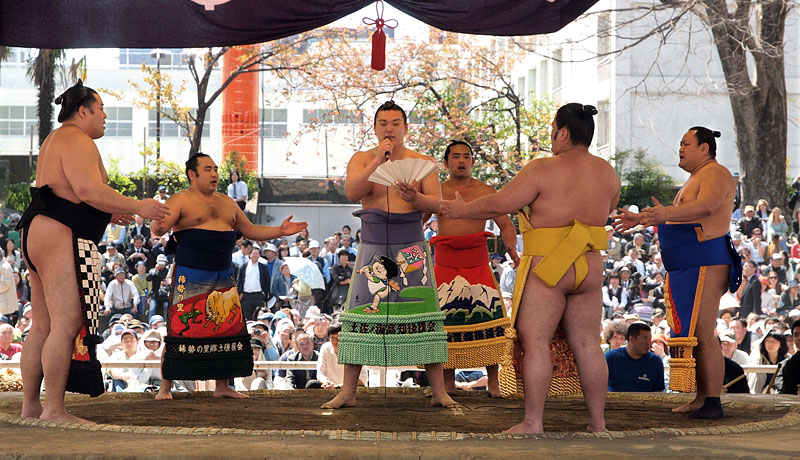
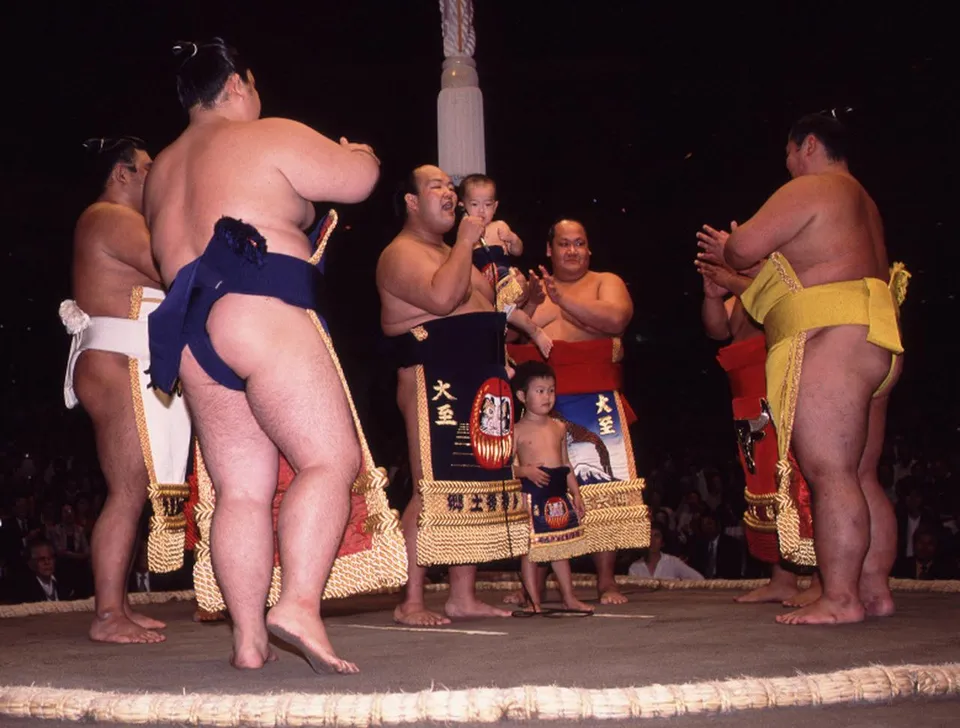
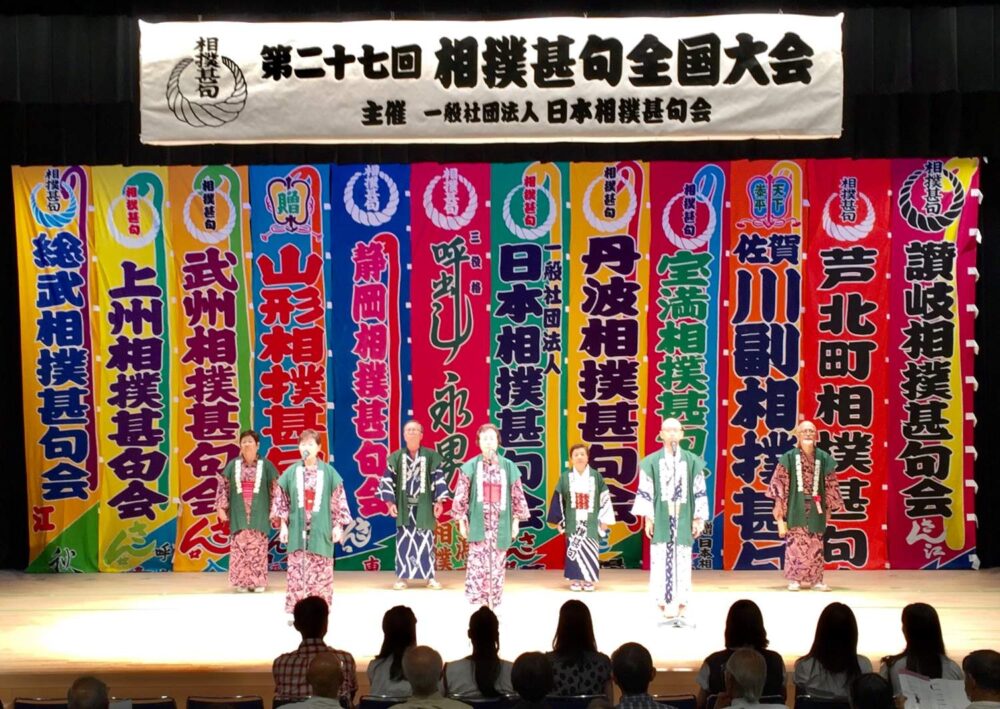
6-4. Shokkiri (comic sumo performance)
Shokkiri is a show in which forbidden moves of sumo are introduced in a funny way. You can watch them in a provincial tour.
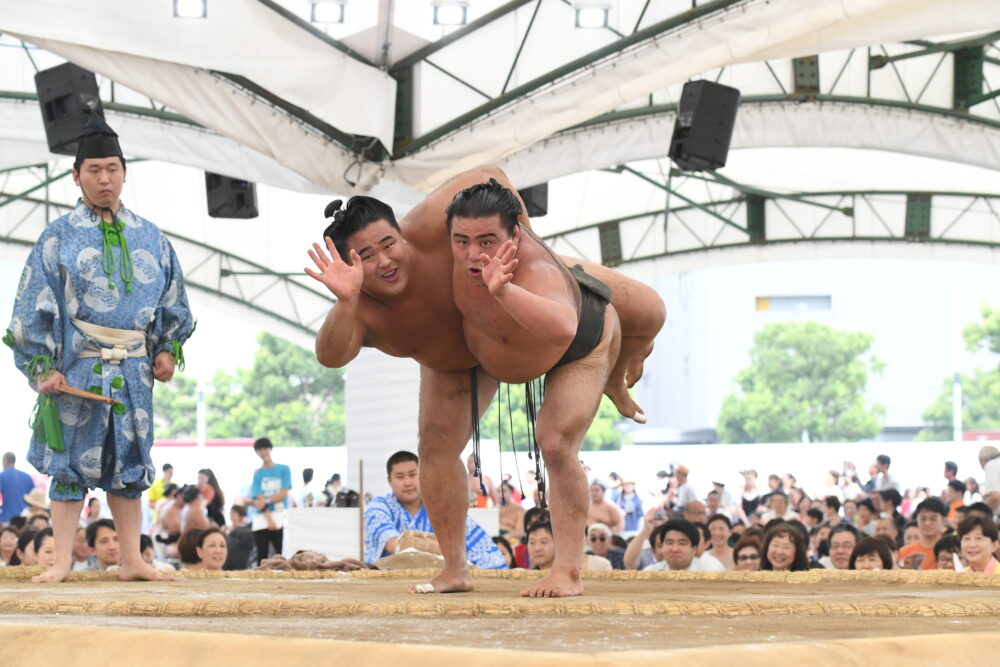
Two rikishi from the makushita rank and a gyoji(referee) step on the dohyo(ring) and compete against each other to perform the following forbidden moves and funny gestures.
- Kicking the opponent down.
- Punching each other with their fists.
- Grabbing each other’s chonmage(topknot).
- Spraying chikara-mizu (power water) in the oppornent’s face.
- Falling down from the dohyo(ring) because of failing to step on the ring.
- Showing techniques from other martial arts.
- When tachiai is about to take place, he puts his hands on the starting line and kicks his hind legs up in the air like a cat, causing the sand to roll up.
- In protest against the oppornent’s foul technique, the fighters exchange hand claps and strike fighting poses with each other, creating a boxing or pro-wrestling-like atmosphere. The gyoji(referee) warned, “In sumo, only slaps are allowed.
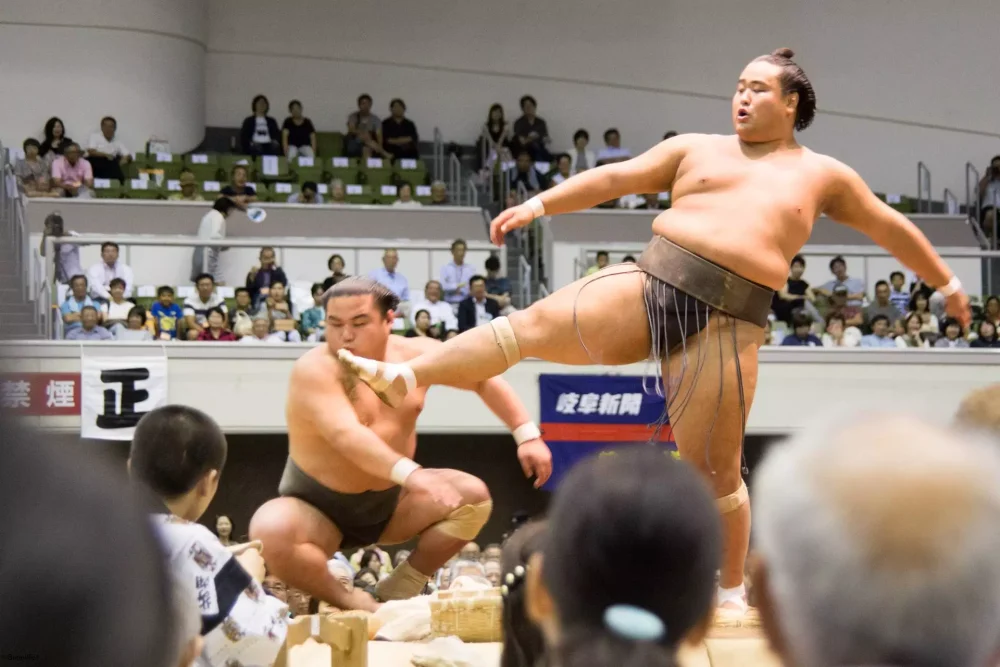
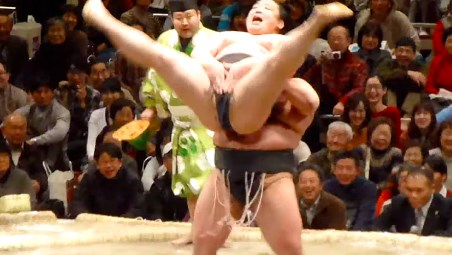
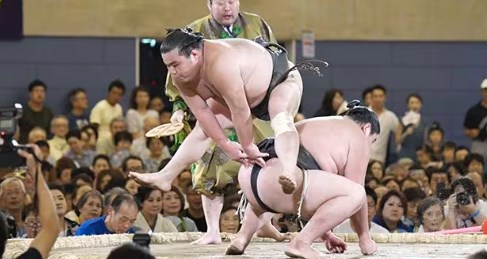
6-5. O-zumo calendar
| Name of tournament | ☆grand tournament ◇jungyo (provincial tour) | Name of the event |
|---|---|---|
| January, Tokyo | ☆ | Grand Sumo tournament |
| March, Osaka | ☆ | Grand Sumo tournament |
| Spring Jungyo | ◇ | Chubu and Kinki region |
| May, Tokyo | ☆ | Grand Sumo tournament |
| July, Nagoya | ☆ | Nagoya Grand Sumo tournament |
| Summer Jungyo | ◇ | Hokkaido and Tohoku region |
| September, Tokyo | ☆ | Grand Sumo tournament |
| Fall Jungyo | ◇ | Kanto and Chybu region |
| November, Fukuoka | ☆ | Grand Sumo tournament |
| Winter Jungyo | ◇ | Kyushu and Okinawa region |
7. Basic training
Basic daily training for Sekitori includes Shiko-fumi stomping, Suriashi(sliding feet), Teppo, and Matawari(Leg-stretching).
7-1. Shiko-fumi (stomping)
Shiko-Fumi is the basic training activity of sumo, performed by Rikishi by raising and lowering their legs. It is intended as a preparatory exercise and to strengthen the legs and hips.
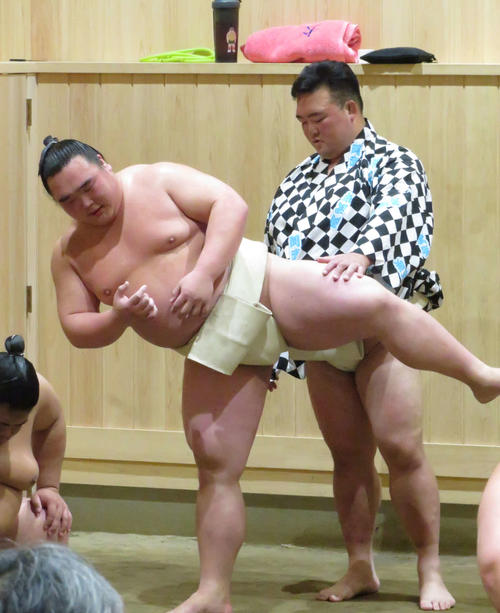
By moving the lower half of the body widely, it can improve the strength of the hips and thighs and the flexibility of the hip joints.
It also strengthens the iliopsoas muscle, one of the inner muscles, which improves body contours and eases the leg lifting movement necessary for a stable gait, helping to prevent falls.
The basic steps of theShiko-fumi are as follows;
- With toes pointing outward, raise your feet higher than shoulder-width apart, alternating from side to side.
- When lowering the feet to the floor, simultaneously lower the hips deeply.
- Keep your back straight and avoid leaning forward.
Shiko-fumi also has a religious meaning: to drive away misfortune from the land and pray for a bountiful harvest by stomping down forcefully on the earth.
In sumo wrestling, it is believed that by stepping on the ground with the wrestler on the ring, dirt, and evil spirits are driven away, and it has the meaning of “a good harvest and good health.
7-2. Suriashi (sliding gait)
Suriashi is a gait exercise in which the foot is slided without releasing the sole from the ground.
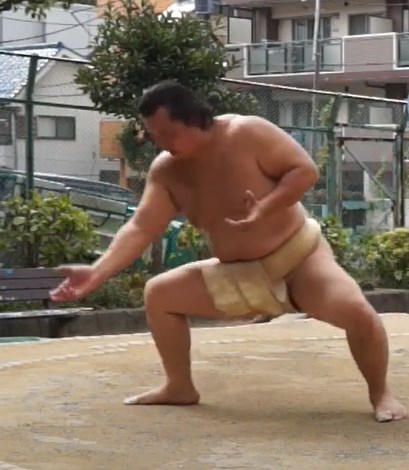
The weight is placed on the inside of the foot, the center of gravity is lowered, and the thumbs of the foot are kept on the ground, which increases the activity of the muscles in front of the thighs.
This movement eliminates the up-and-down motion of the body and is suitable for smooth movement, making it an ideal training for martial arts.
7-3. Teppo (Thrusting a post)
Teppo is one of the traditional training methods of sumo. Repeated left and right thrusts are made toward a post called Teppo-bashira(post).
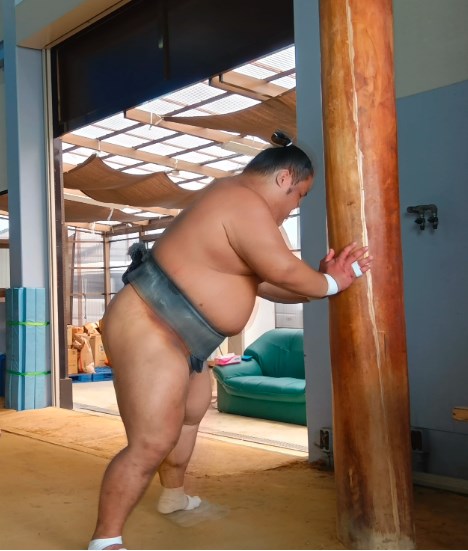
It moves and conditions the shoulder blade area. It is useful for injury prevention.
Teppo is usually performed as a series of movements with sliding feet. This is to acquire the basics of hand and foot movements when attacking. It is not only weight training for the upper body but also helps to master footwork.
7-4. Matawari (leg-stretching)
Leg-stretching exercises are preparatory exercises to make the hip joints flexible and prevent injury.
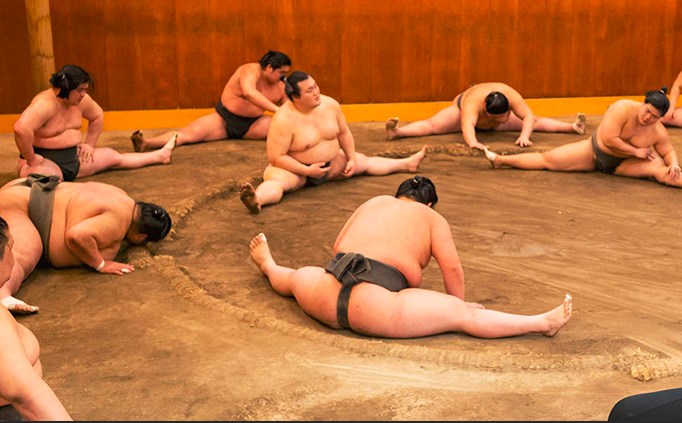
It is not uncommon for sumo wrestlers, for example, to become accustomed to it through years of practice and be able to open their legs to 180 degrees and even bend their upper bodies so far that their faces touch the ground. If inexperienced wrestlers do this too quickly, they may end up damaging their ligaments.
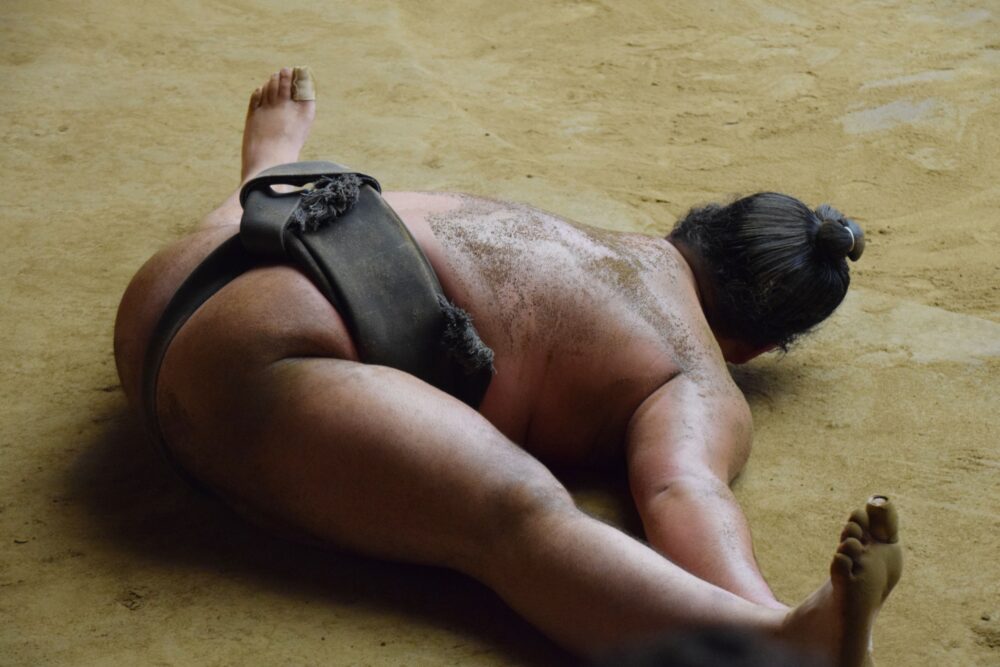
It is often referred to as “the most rigorous of all sumo training,” and many new apprentices consider it a terrifying practice. The length of practice required to perform a correct crotch split depends on the flexibility of the individual. Generally, several years are required.
The flexibility of the hip joints is to prevent injury. When the body is soft, muscles are less likely to be damaged and the joints have a wider range of motion.
8. Chanko nabe (sumo hot pot)
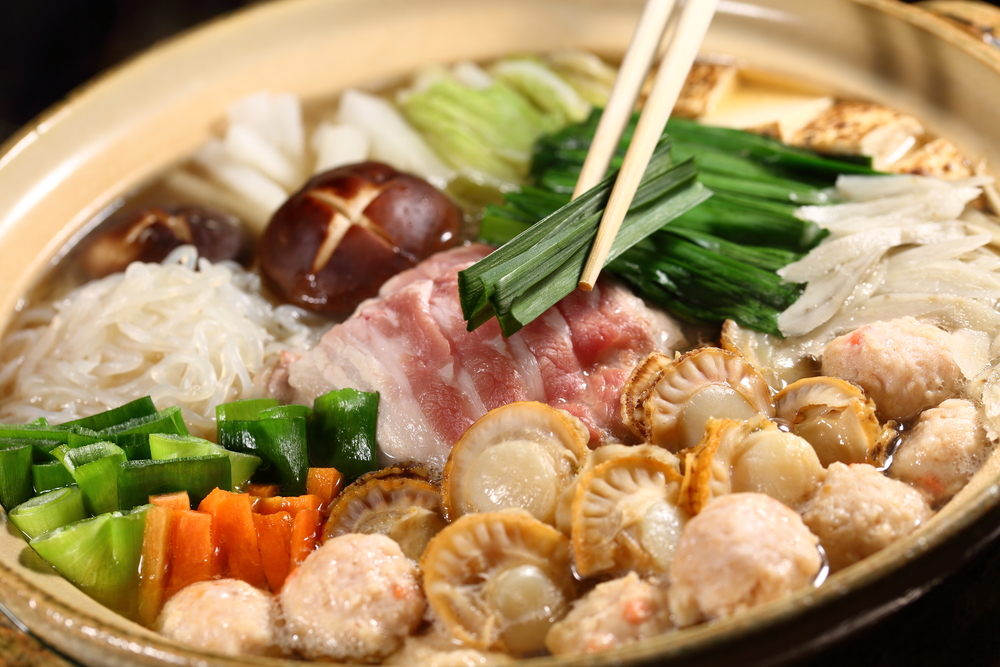
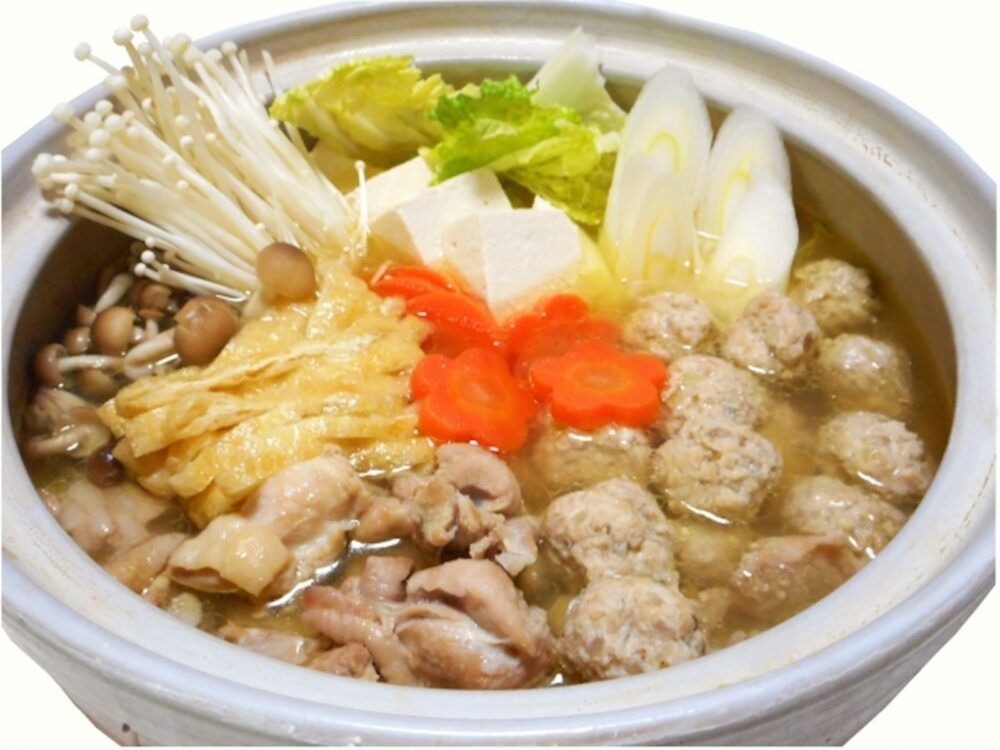
Rikishi eats two meals a day, one for brunch after morning training and one for dinner.
The most famous dish that rikishi eats is a hot pot dish called chanko-nabe.
Sumo wrestlers eat chanko-nabe and numerous other nabe dishes on a daily basis, but the ingredients and flavors change from day to day, so they say they never get bored.
When cooking the chanko-nabe, vegetables are torn directly by hand and put in, and meat and fish are roughly cut and put in to make a bold dish.
The Rikishis used to eat usually chicken. Pork and beef were not eaten before because pigs and cows walk on four legs, which for sumo wrestlers means losing the sumo match.
These days since around 1965, Rikishis no longer carry such superstitions and eat both beef and pork.
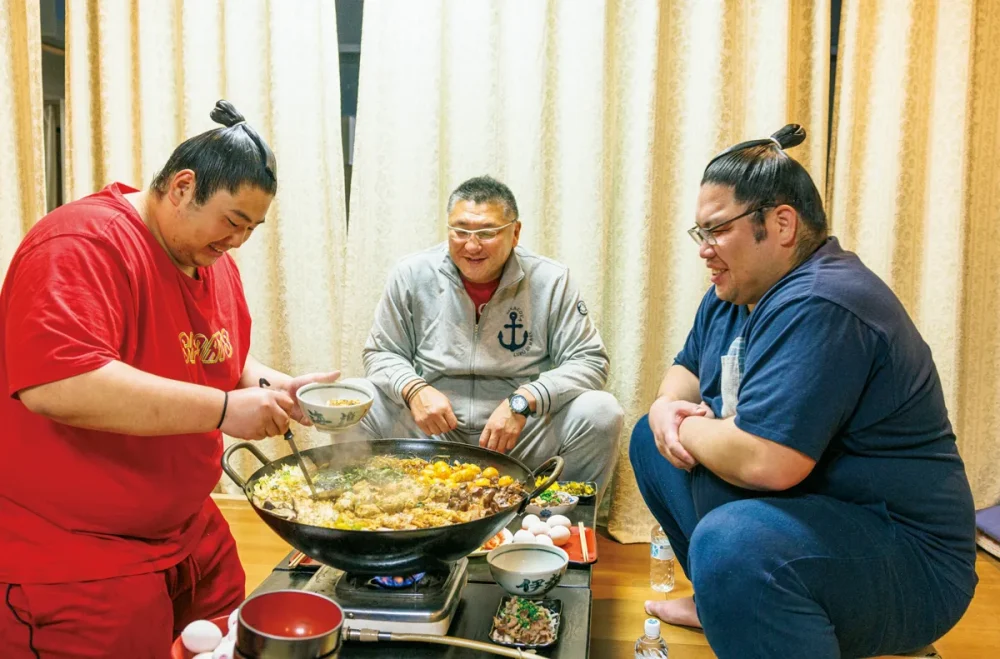

9. Mage (sumo topknot)
What makes Japanese sumo unique compared to other sports is its topknot. The topknot is commonly known as a chonmage. All rikishi, from yokozuna to the lowest ranks, live in chonmage.
When a rikishi rises to the rank to juryo or higher, he wears an “ohicho,” an inflated ginkgo leaf-like spread at the back of the head or other parts of the head, during matches during tournaments.
In Japan, before the Meiji Restoration, all adult males wore chonmage. Samurai wore two swords at their waists.
In August 1871, after the Meiji Restoration, it became a law to cut off the chonmage, shorten the hair on the head like Westerners, and not carry a sword.
Sumo wrestlers also tried to shorten their hair, but because many people liked sumo among the directors of the Meiji government at that time, it was decided to allow sumo wrestlers to wear their hair in the same manner as before, and this has continued to this day.
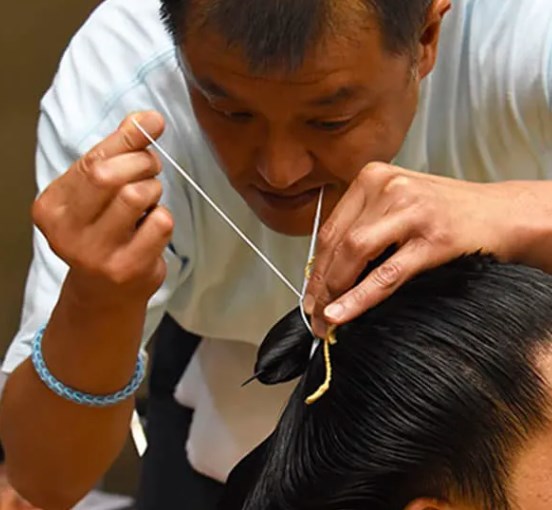
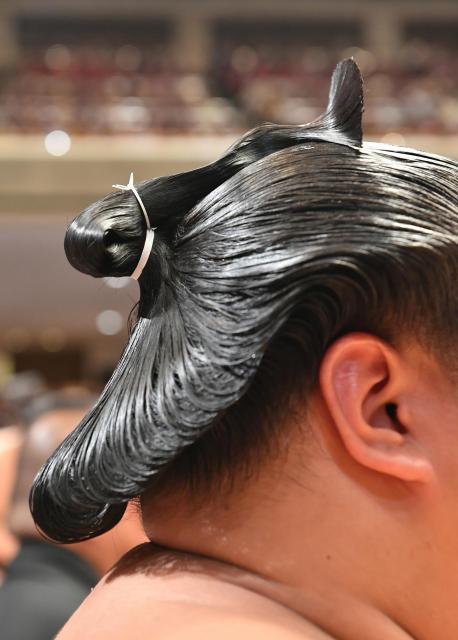
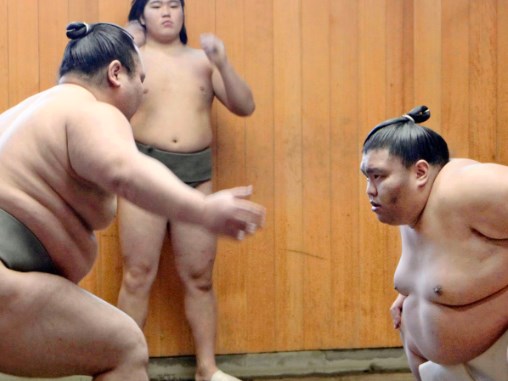
10. Kokugi (national sport) and Shinji(Shinto ritual)
10-1. Orijin of Sumo
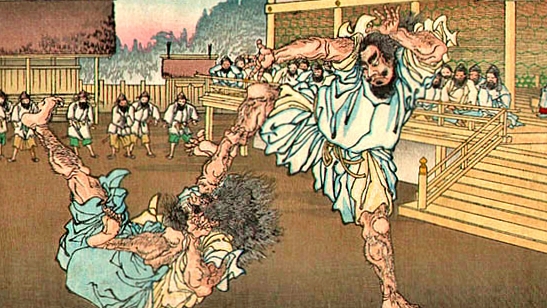
Sumo is one of the oldest fighting sports as a battle without weapons.
The oldest record of sumo is found in the myth in the Kojiki (712) and Nihonshoki (720), the oldest history books in Japan, which is said to have originated as a contest of strength between gods.
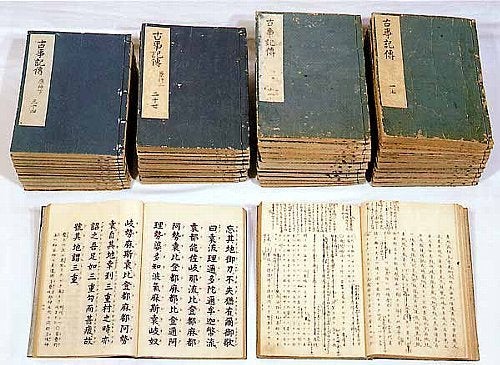
On the other hand, sumo by humans is said to have originated when Nominosukune and Taimanokehaya held a tenran-zumo(See 3. Tenran-zumo) before Emperor Suinin, the 11th Emperor of Japan. This was 1400 years ago. Sumo was to be held annually as a festive ritual to divine the harvest of the year’s crops.
10-2. The Boast of Strength in the Samurai period
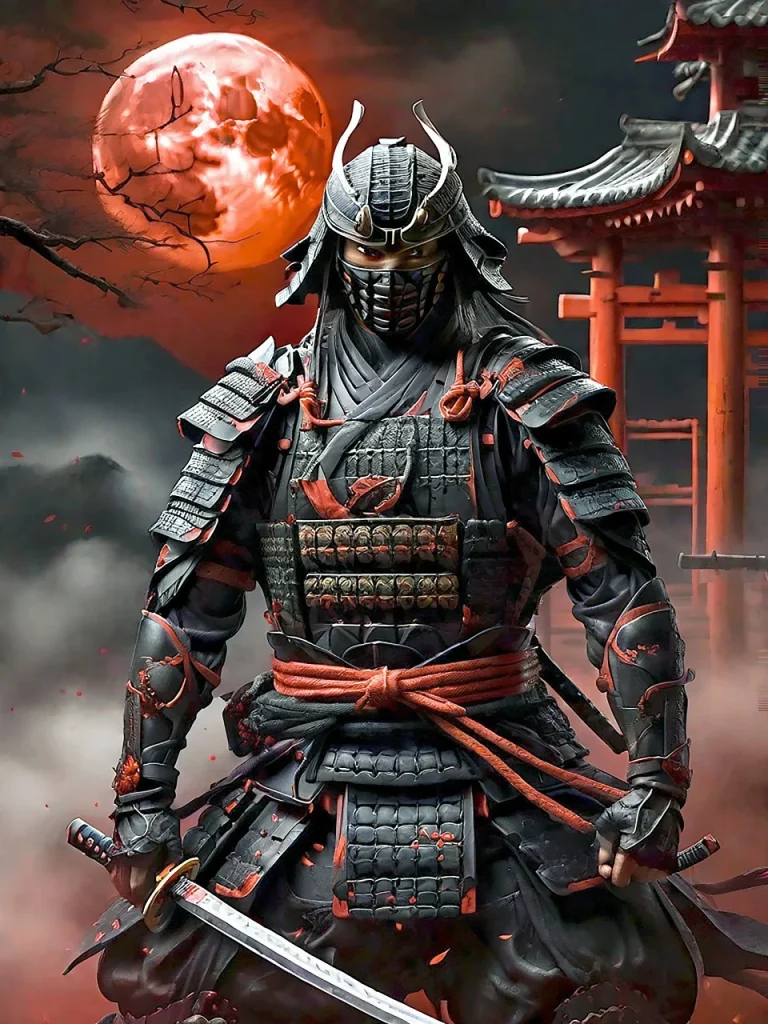
The Kamakura period (1185-1333) to the Sengoku period (1467-1568) was the era of the samurai. Sumo wrestling was actively practiced as a combat training for warriors. Oda Nobunaga, a long-time sumo aficionado, held a sumo tournament at Azuchi Castle in Omi and other locations from 1570 to 1592, gathering wrestlers from all over the country and enlisting the winners as his vassals.
10-3. Maijor Entertainment in Edo peroid.

In the Edo period (1603-1868), sumo became a profession among ronin and those who boasted of their strength. Kanshinzumo began to be held throughout the country, and by the mid-Edo period, sumo was being regularly performed. Sumo tournaments were also held for the shogun’s pleasure, and sumo’s popularity grew rapidly, leading to the establishment of the foundation for today’s grand sumo tournaments. Along with Kabuki, Sumo became a major element of the general public’s entertainment.
Sumo has gradually become a traditional culture unique to Japan through rules, refinement, and stylization over its long history since the Edo period, and has taken on the form of a sport.
10-4. Kokugi(national sport)
Sumo is strongly associated with Japan’s national sport, but, there is actually no legally recognized national sport in Japan.
However, sumo, which has long been popular among the people, is accepted as the national sport by many Japanese. The Nihon Sumo Association accepts that the Kokugikan, the name of the sumo venue three times a year, is a symbol of national sport.
In 1909, the first permanent sumo hall was completed in Ryogoku, Tokyo, and named “Kokugikan.
In the dedication written by writer Emi Suiin at the opening ceremony, he wrote, “Sumo is the national sport.” The building was named “Kokugikan”.
At this point, sumo became not only a Shinto ritual but also the national sport, and this is the reason why sumo is considered the national sport of Japan.
The current Kokugikan (pictures) is the second one and was completed on November 30, 1984, after three years of construction.
It has two floors above ground and one below, with a capacity of more than 10,000 spectators.
It is used for martial arts such as professional wrestling and boxing, other sporting events, and as a venue for live performances of popular music. Classical music concerts have also been held there.
10-5. Shinji(Shinto ritural)
Sumo has close ties to Shinto, an ancient Japanese religion.
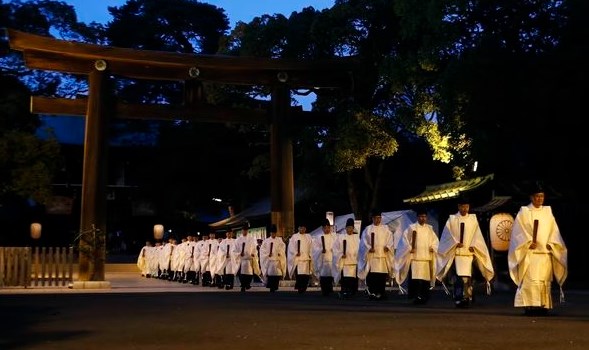
For example, in 725, when Japan suffered from a poor harvest, Emperor Shomu prayed at 21 shrines, including the Ise Jingu Shrine, blessing Myojin (a great god).
A bountiful harvest occurred the following year, and the people dedicated a ritual sumo match at their shrine.
After this, they continued to dedicate sumo, ritual dance, yabusame (archery on horseback), and umakurabe (horse racing) at the shrine. These festivals are still held today to pray for peace, the prosperity of descendants, a good harvest, and a plentiful fish catch.
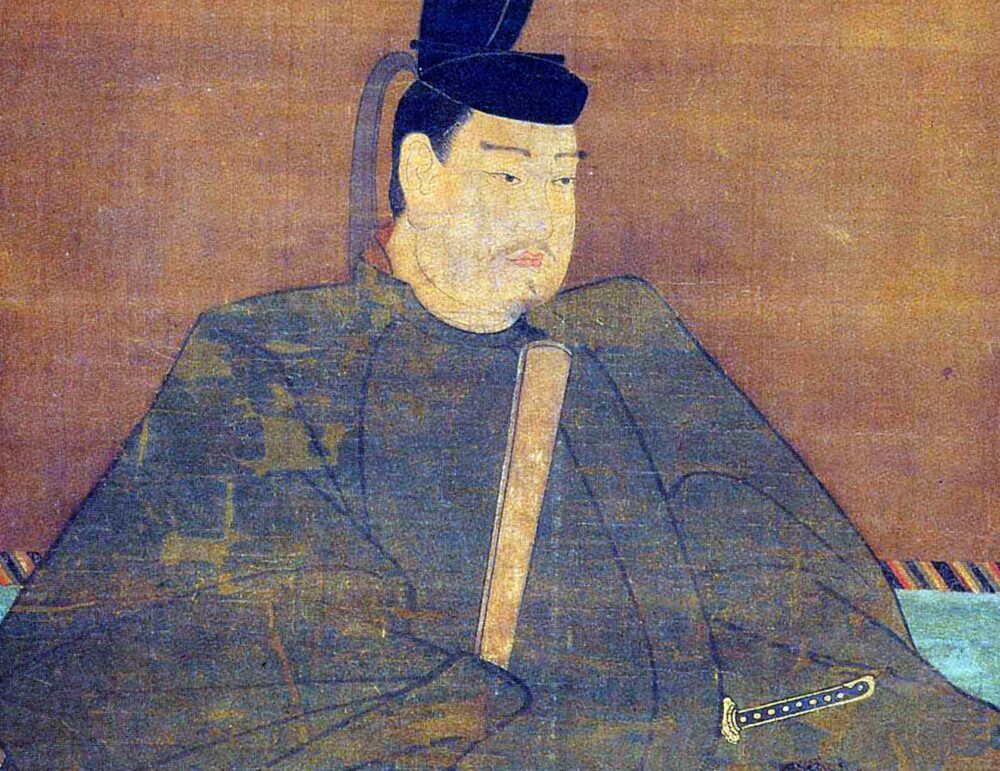

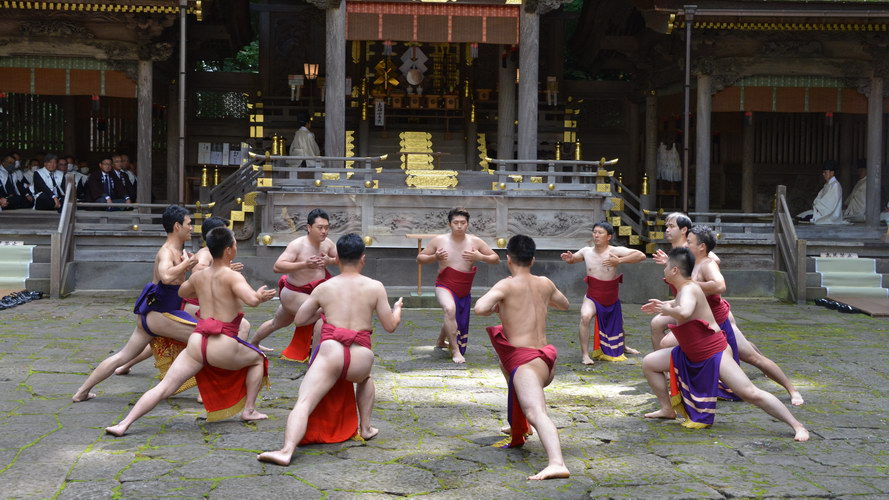
11. Tickets / Arena seats
A good way to watch sumo during your visit to Japan is to attend one of the six Grand Sumo tournaments held each year, three in Tokyo, one each in Nagoya, Osaka, and Fukuoka. Each event lasts 15 days, and tickets are for one day.
Jungyos are also available for watching. Check the English page of the Japan Sumo Association for locations, dates, and other information.
11-1. Tickets
Tickets for both sumo Grand Tournaments and Jungyo can be purchased by phone or over the Internet, but they are very popular and not easy to purchase, even for Japanese.
I recommend that you contact a travel agency in Japan several months in advance of your desired date of visit. It is impossible to buy tickets after arriving in Japan.
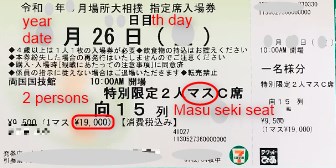
11-2. Seats
There are three main types of seats for sumo spectators.
- Tamari seki seats
- Masu seki seats
- Isu seki (chair) seats
①Tamari seki seats

These seats surround the ring and are the same as ringside seats for boxing. Since they are close to the ring, visitors can watch the matches with great intensity.
Eating, drinking, using cell phones, and taking photos or videos are prohibited, as two rikishis may roll out of the ring.
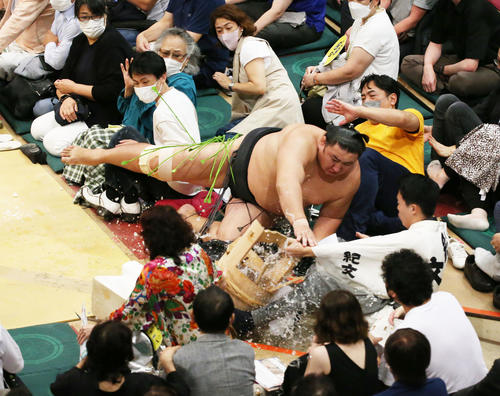
If a rikishi falls from the ring and injures you, first aid will be provided on the day of the event, but no subsequent guarantees will be made.
The fee is 20,000 yen per person (tax included), which is not something that can be easily afforded.
There are no chairs. You will take off your shoes and watch the games on tatami mats.
②Masu seki seats
One section (for 4 persons) is a 1.3 m square steel pipe enclosure seating area with 4 zabutons(cushions) inside. These seats are often used by traditional patrons.
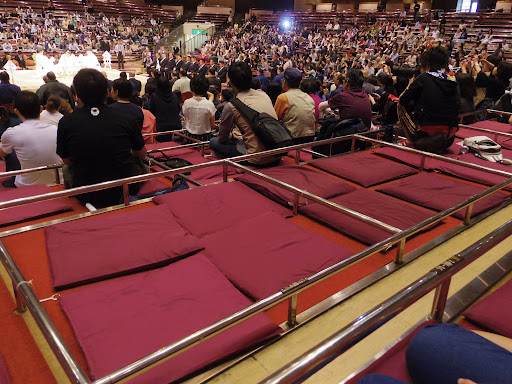
These seats are relatively popular among the three seats. There are also seatings for 1 to 6 persons.
In these masu seats, you are free to eat and drink, and can enjoy watching sumo to your heart’s content while eating a bento(lunch) box and yakitori (grilled chicken) or drinking sake.
There are no chairs. Take off your shoes and watch the matches on tatami mats.
There are four types of prices, ranging from 8,500 yen to 14,000 yen, depending on the position and distance from the ring. On Saturdays, Sundays, and national holidays, the price is 1,000 yen higher.
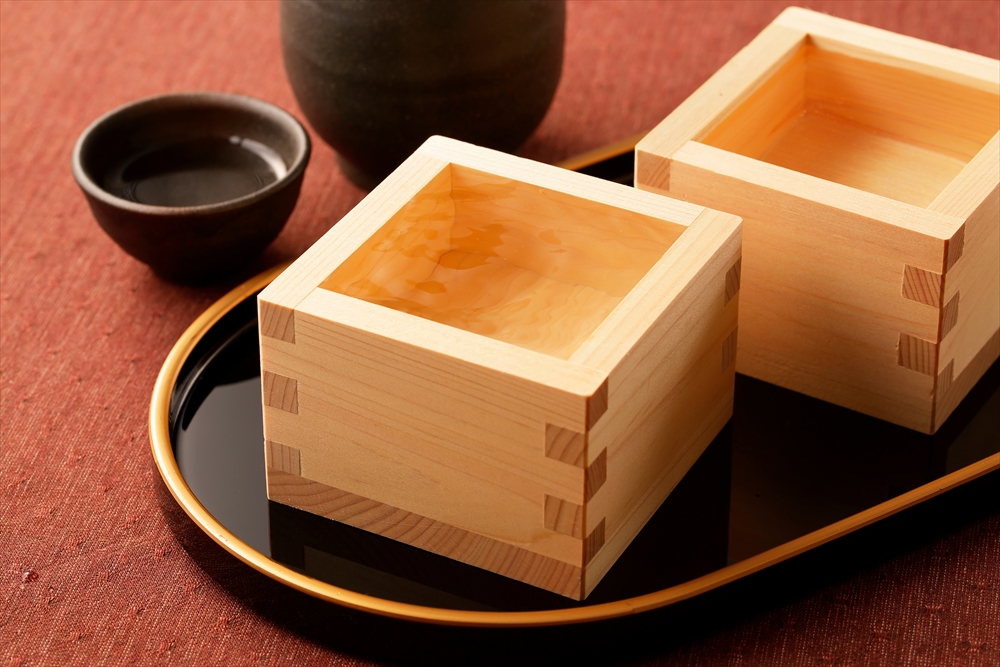
Masu of masu seat is a wooden box that was often used in the past to measure the amount of liquids and grains.
Today, you can enjoy Japanese delicious sake with smaller masu.
③Isu (chair) seki seats
Seats are western style chairs for spectators to sit and watch the matches. They are located on the second floor.
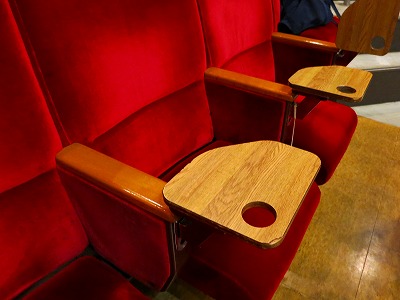
You can look into the ring from above, and although you are far away from the ring, you will feel a unique sense of openness.
For a reasonable price, you can enjoy the atmosphere of the place while watching sumo.
Prices are divided into four categories, ranging from 3,500 yen to 9,000 yen (weekdays), depending on the location. On Saturdays, Sundays, and holidays, the price is 500 yen higher each.

